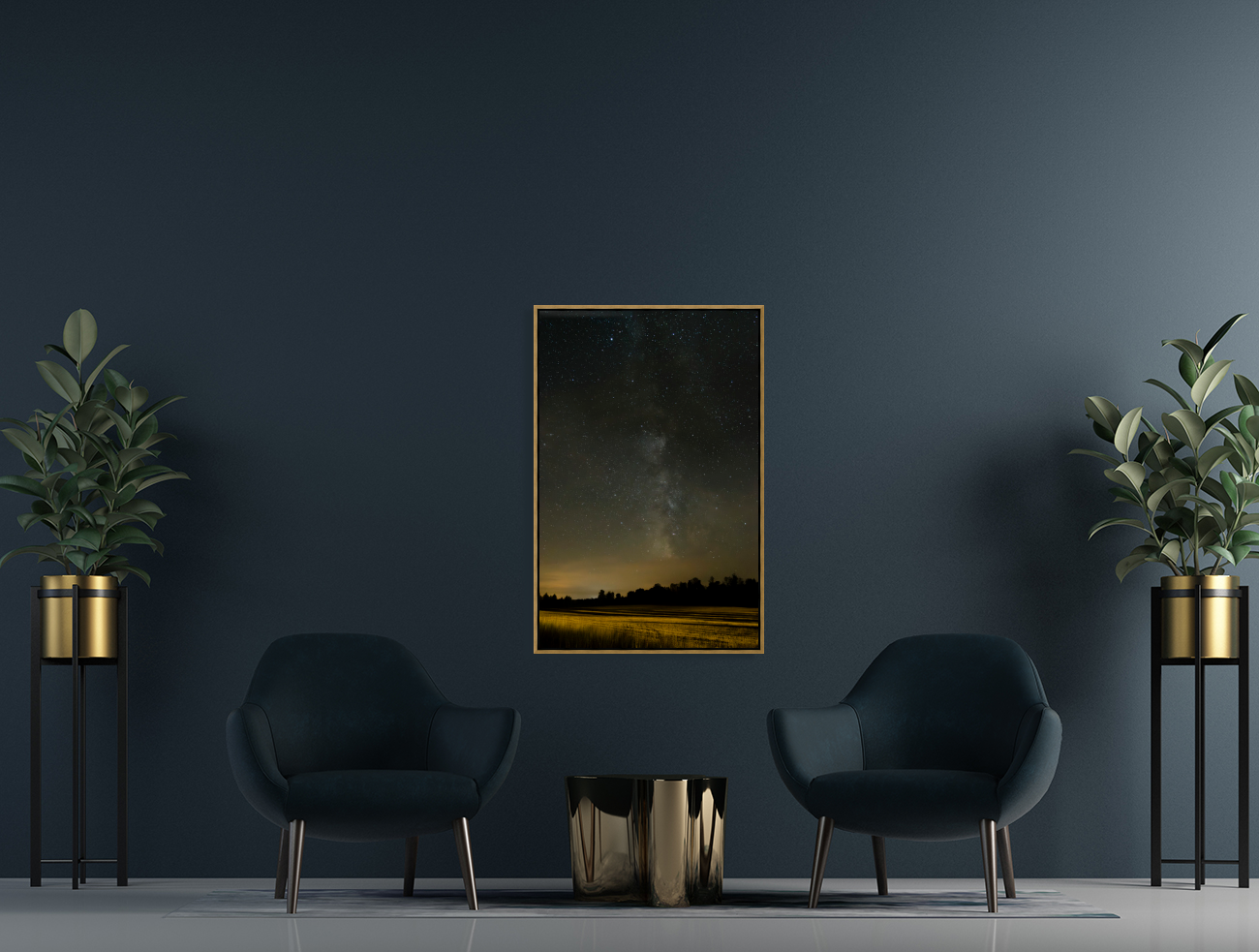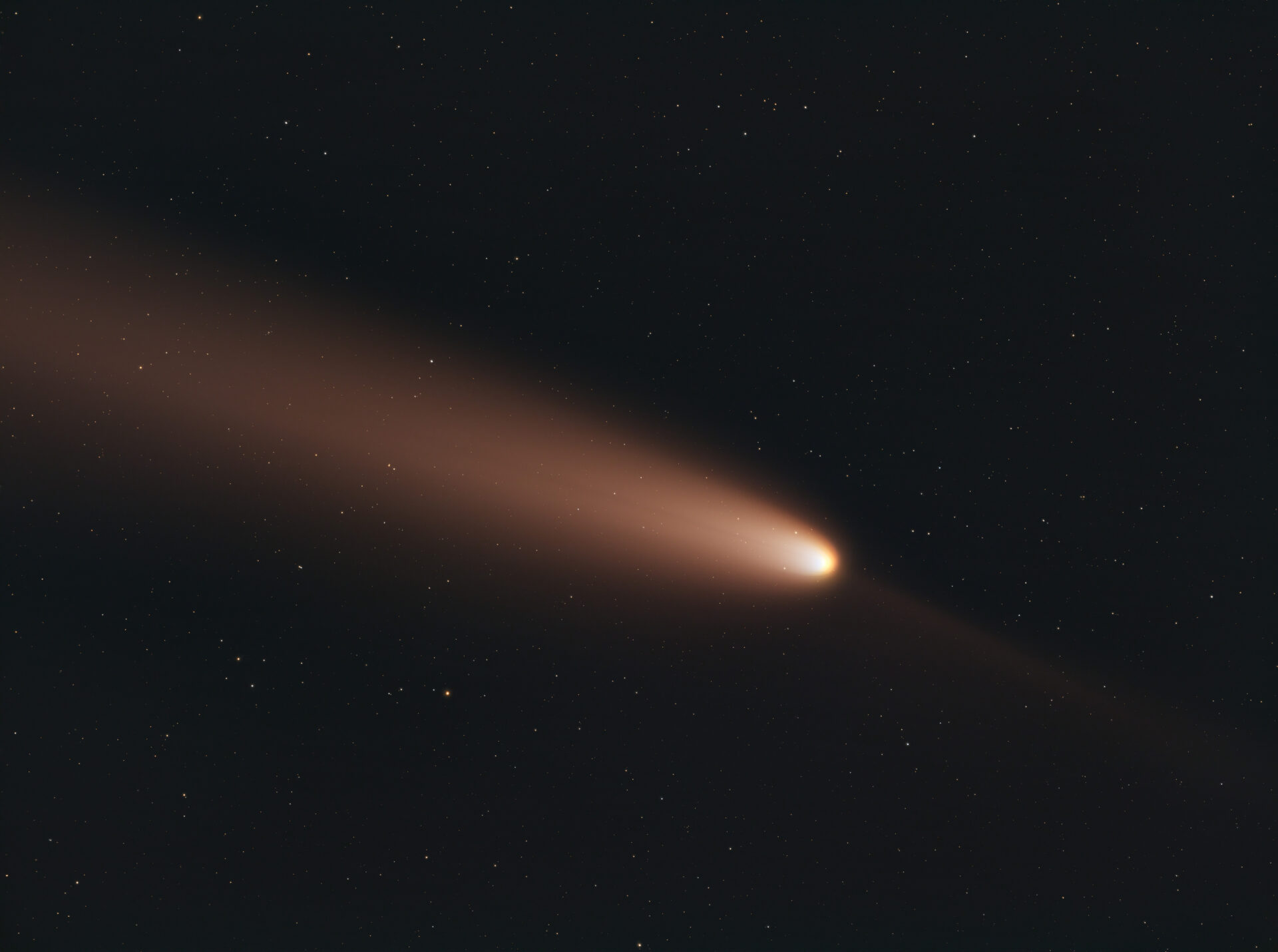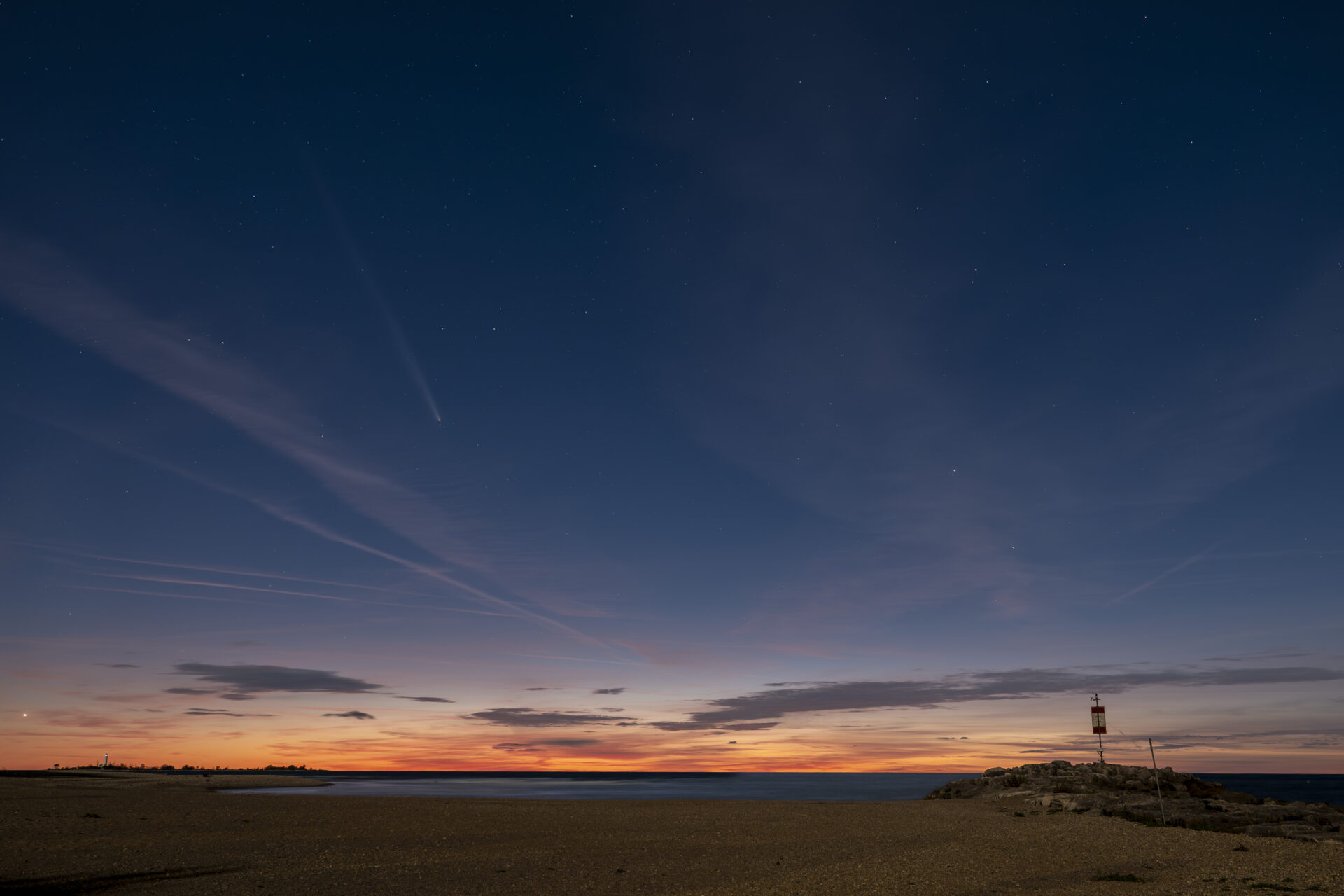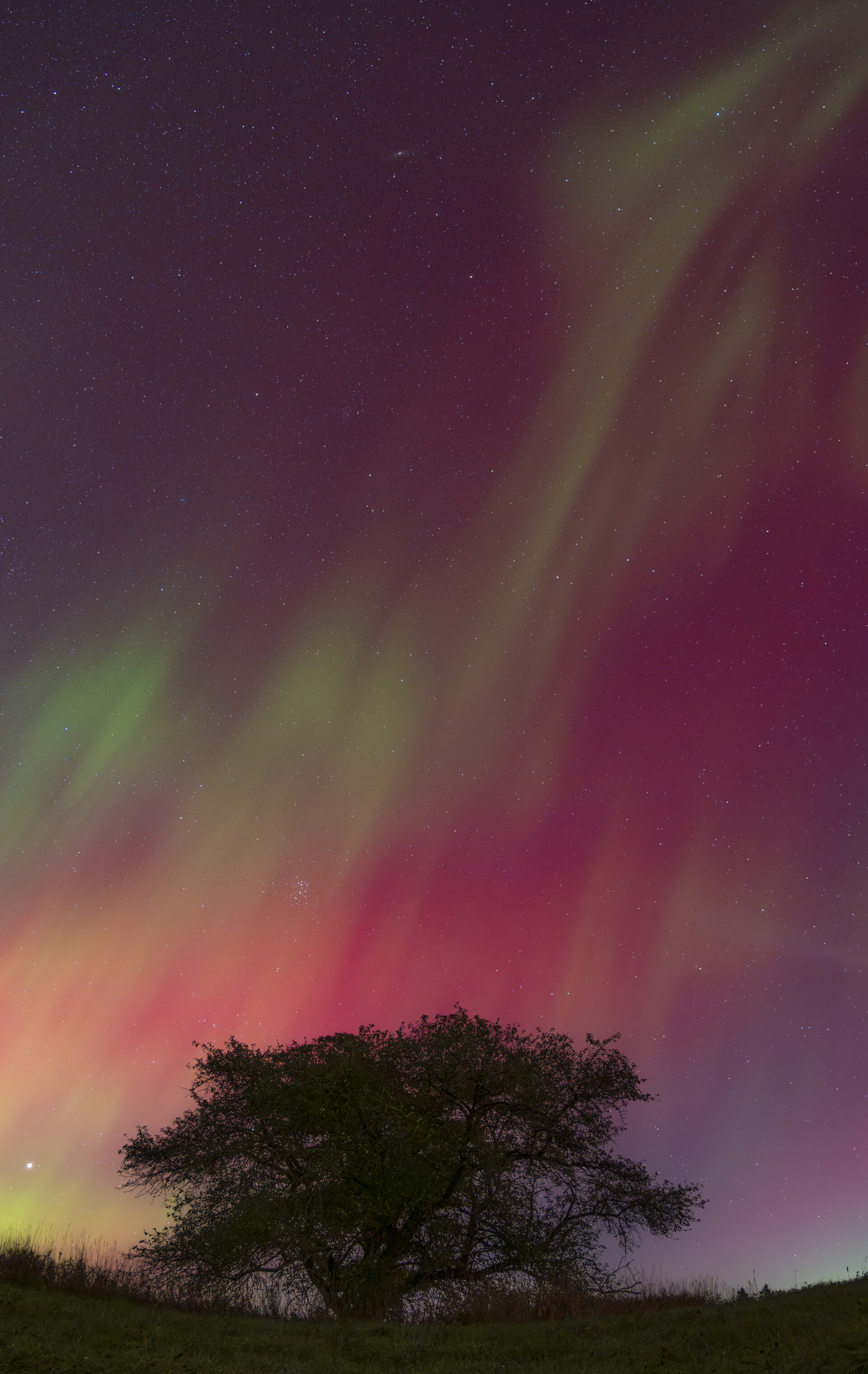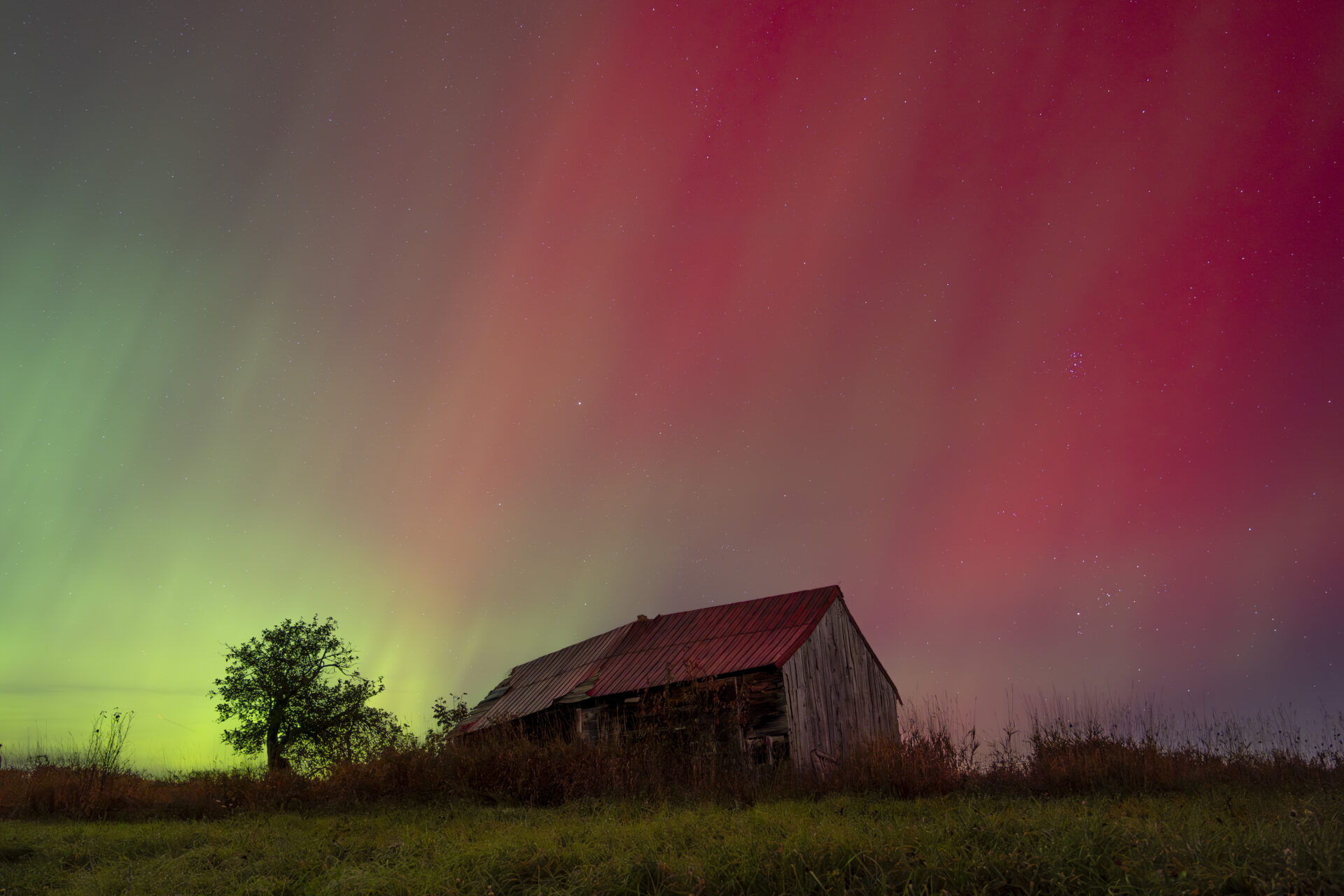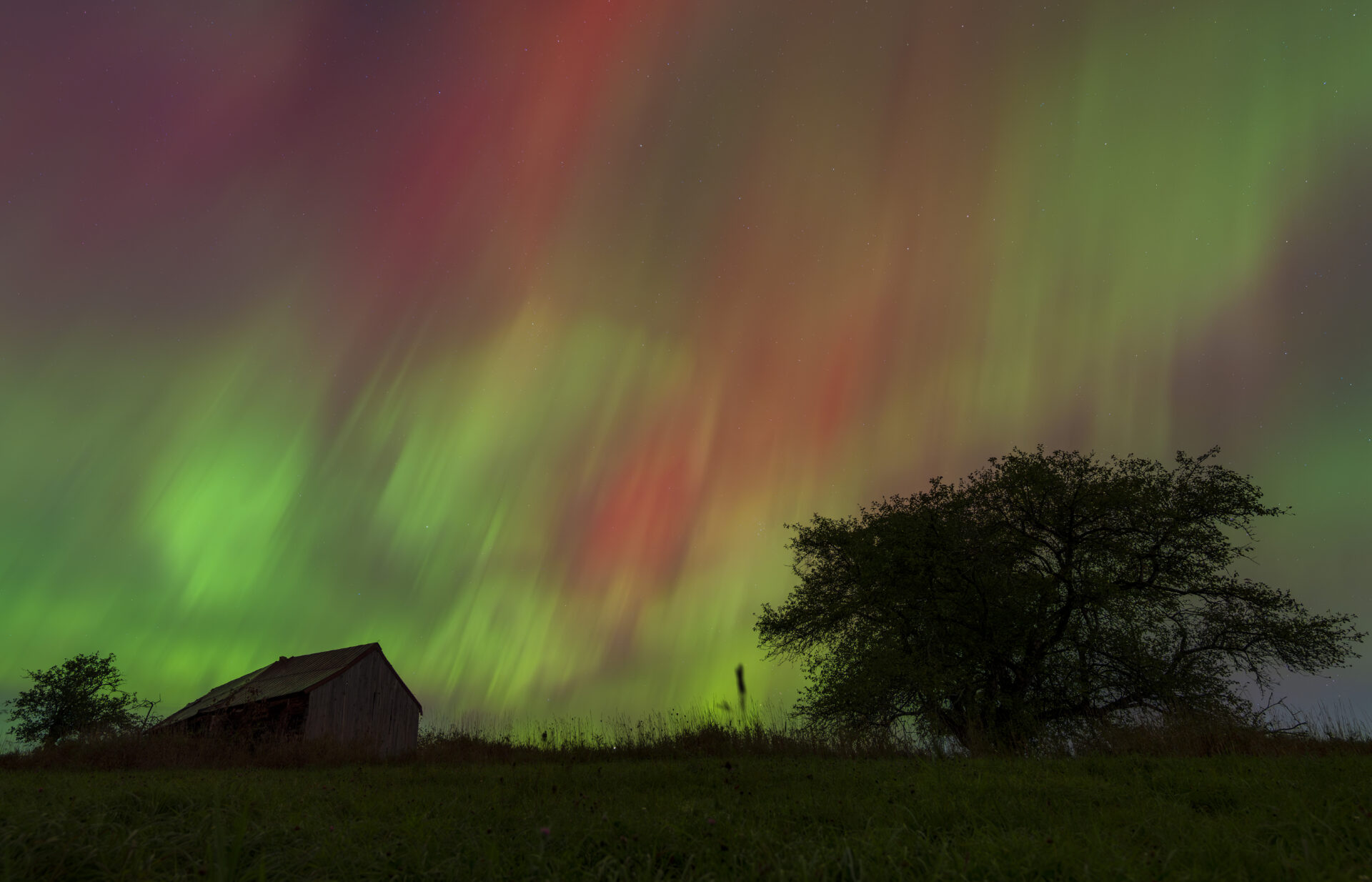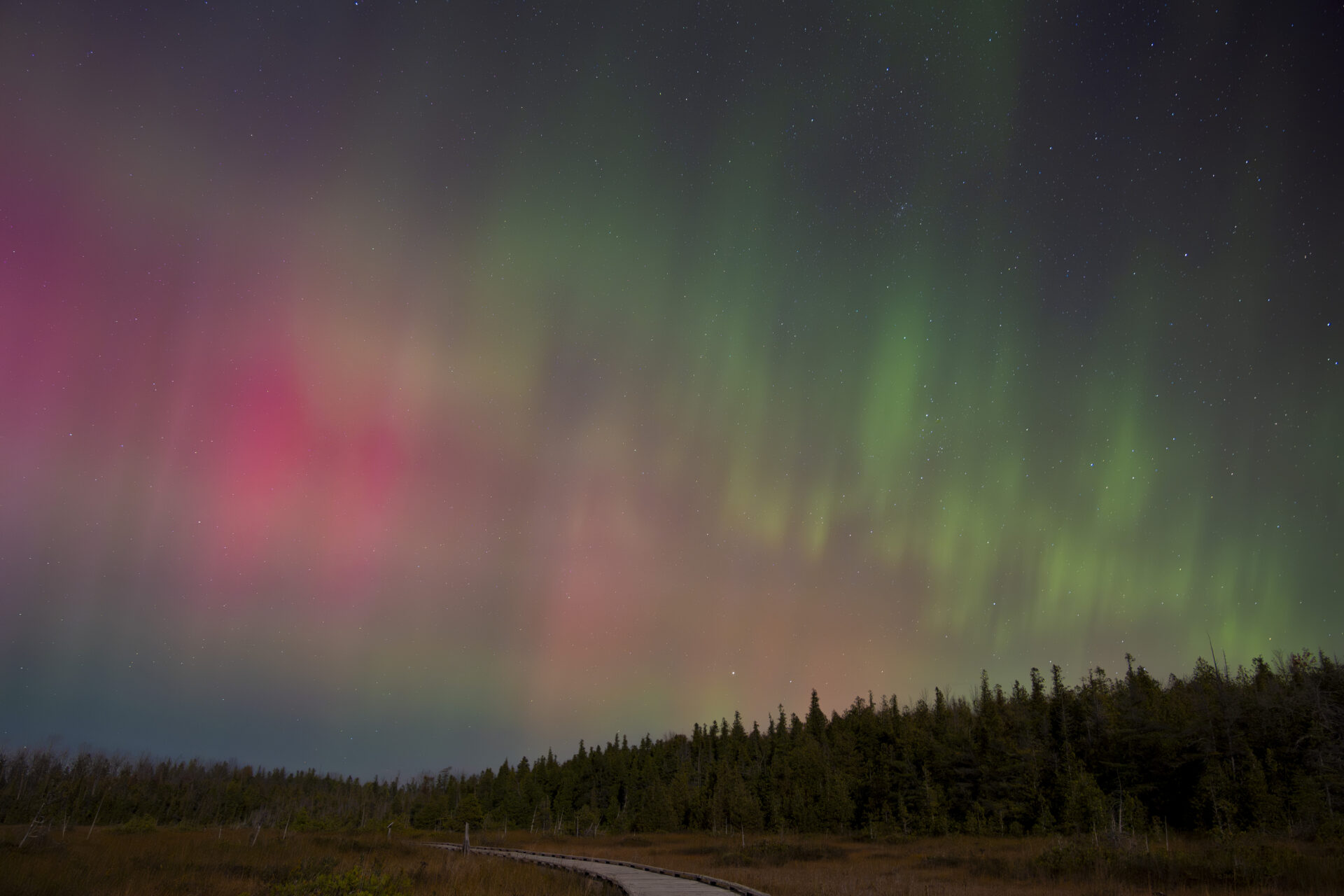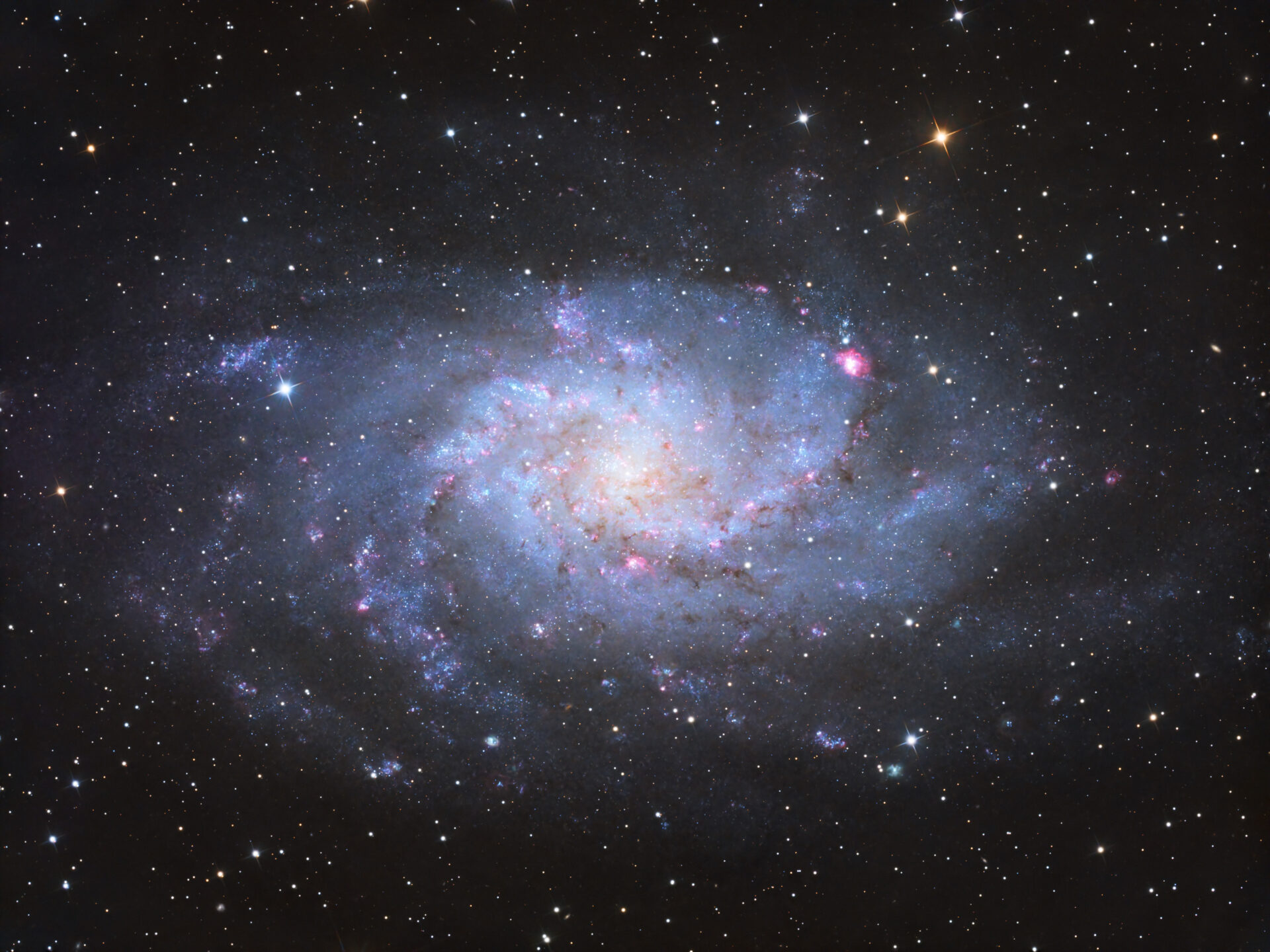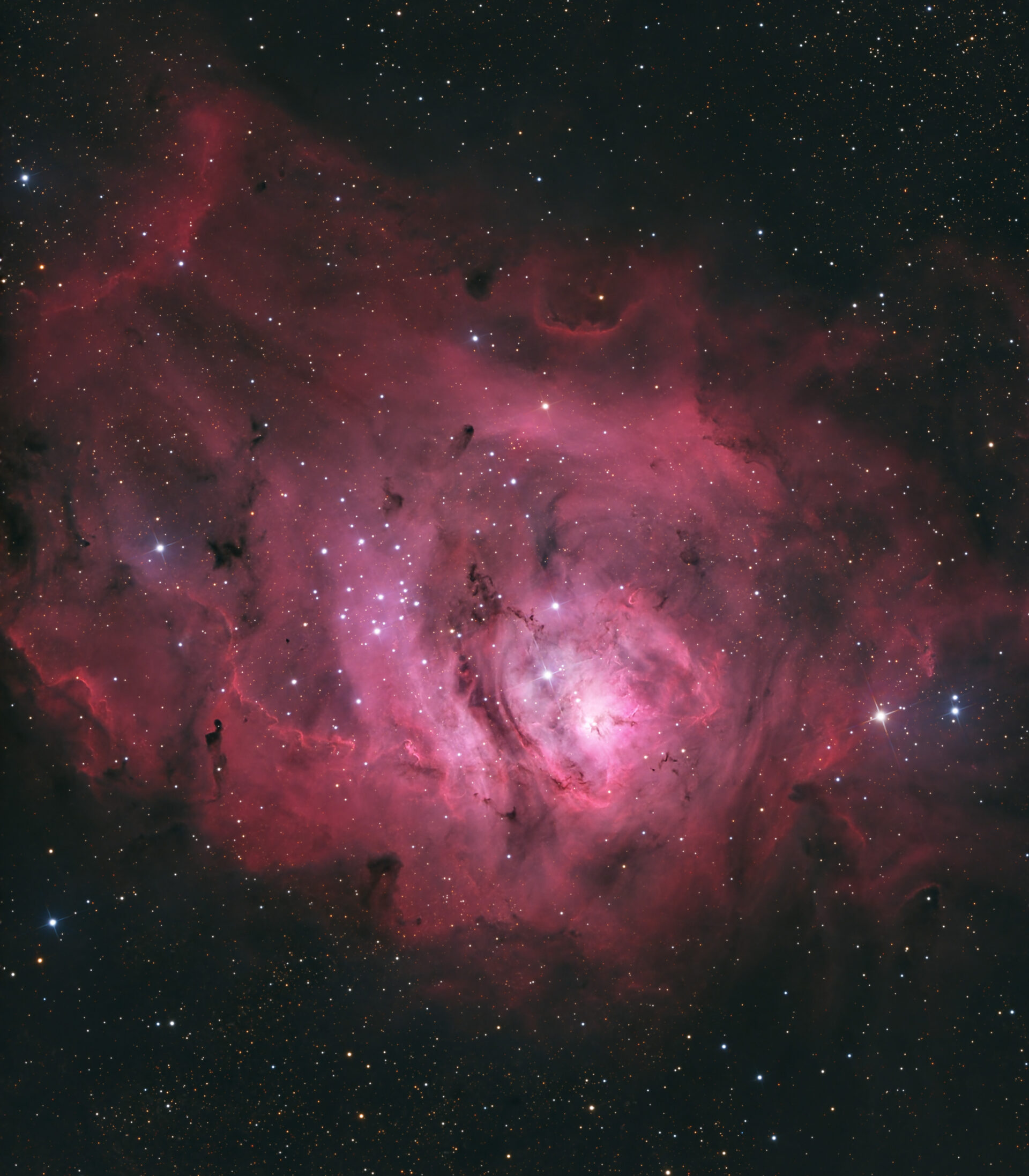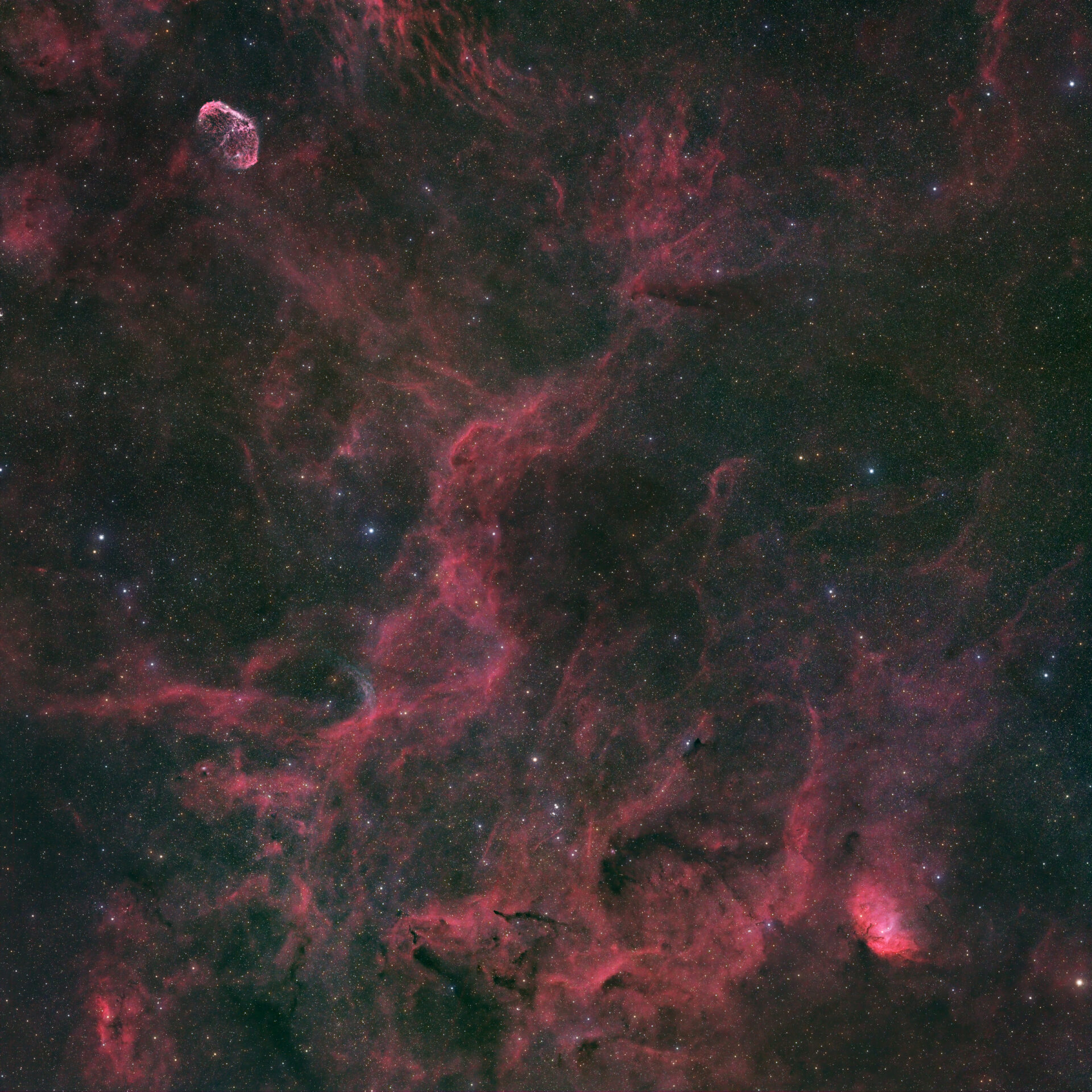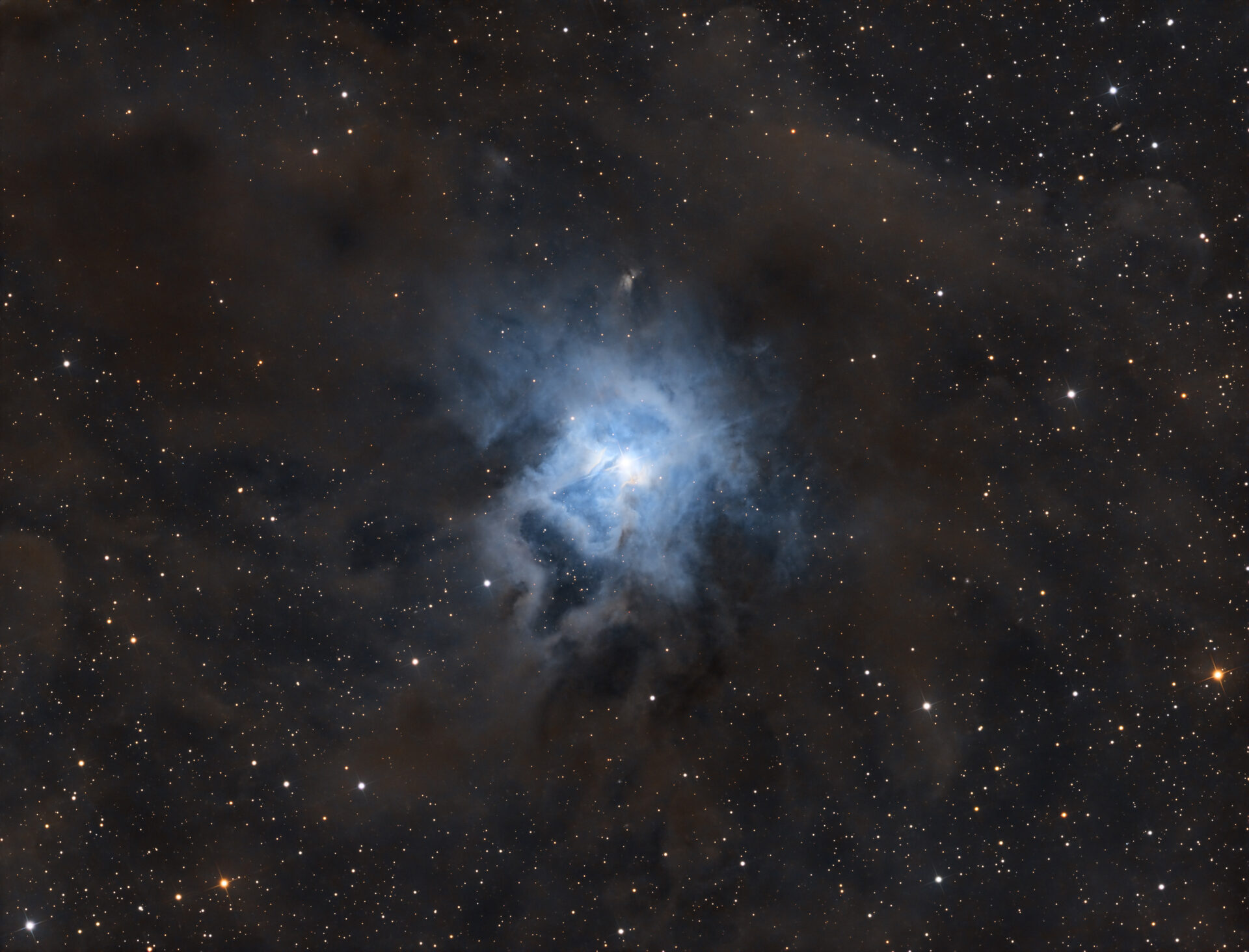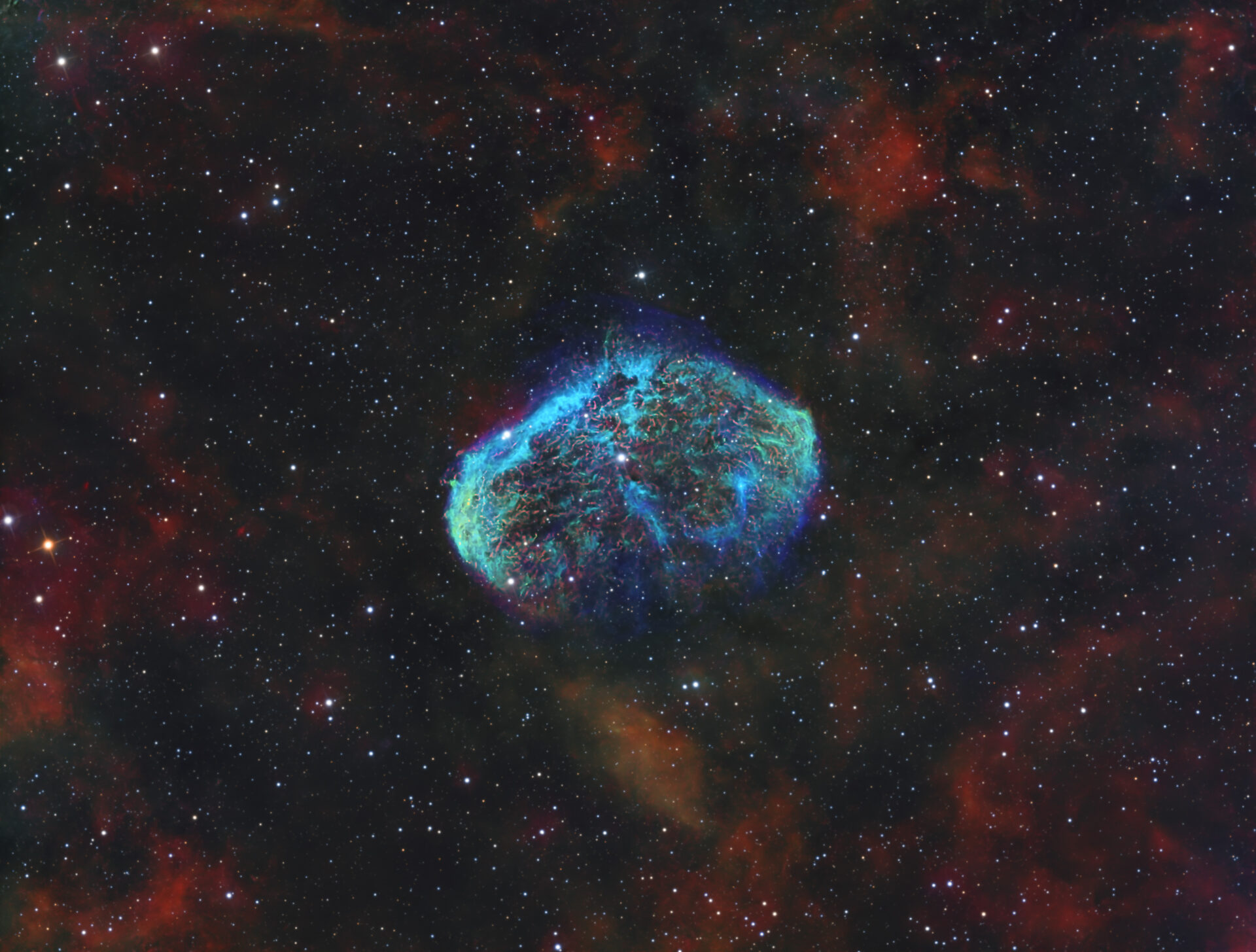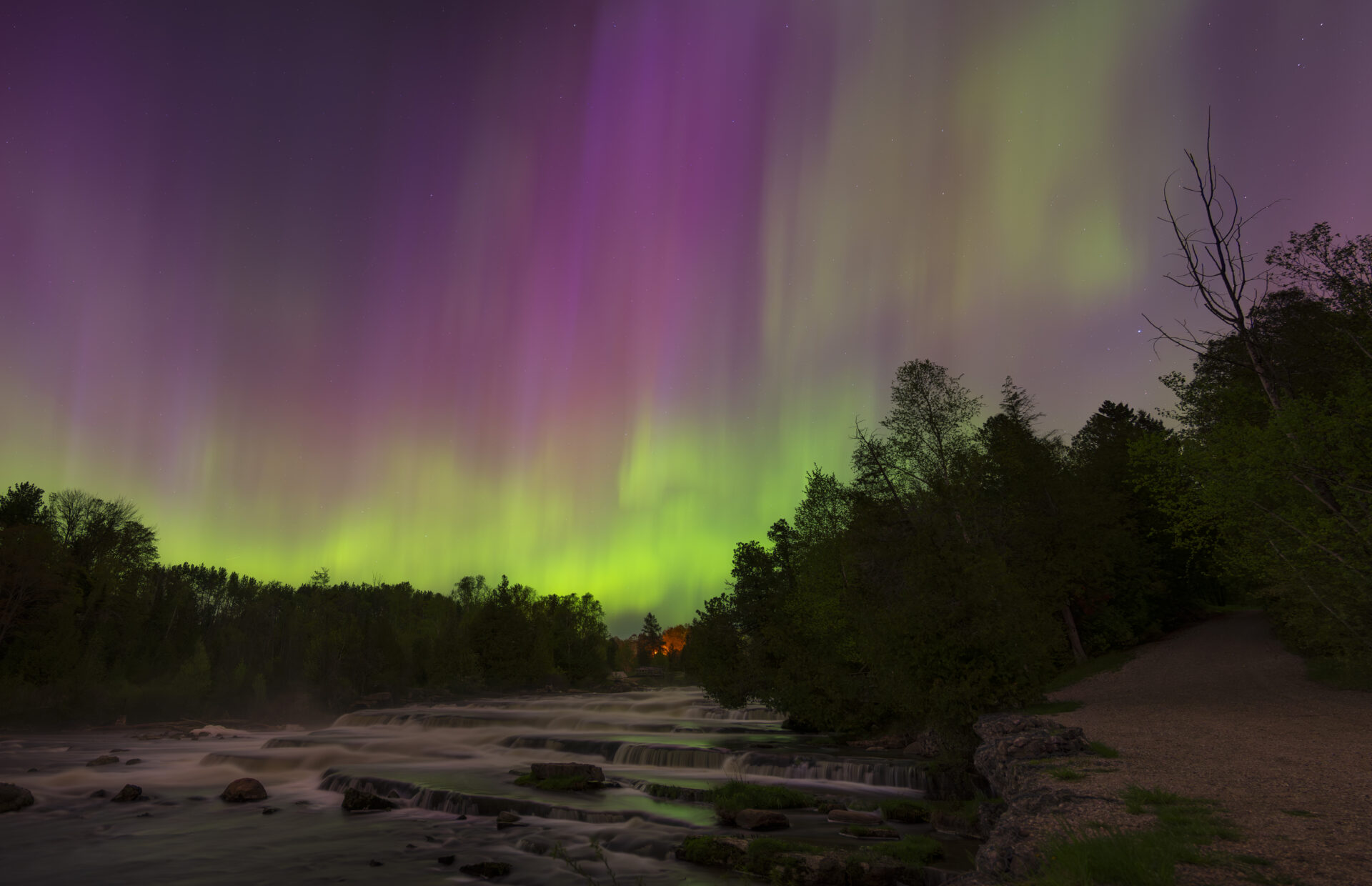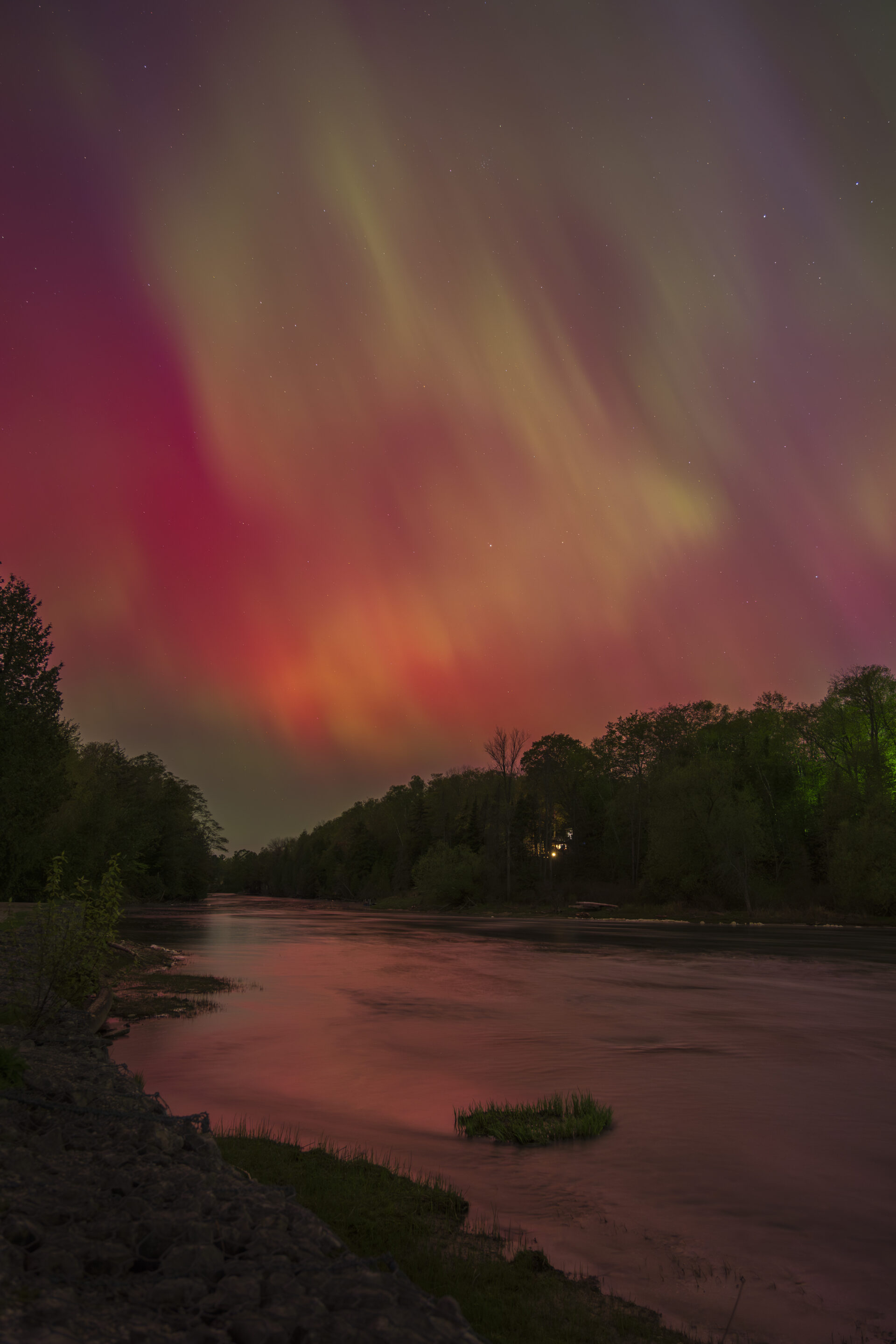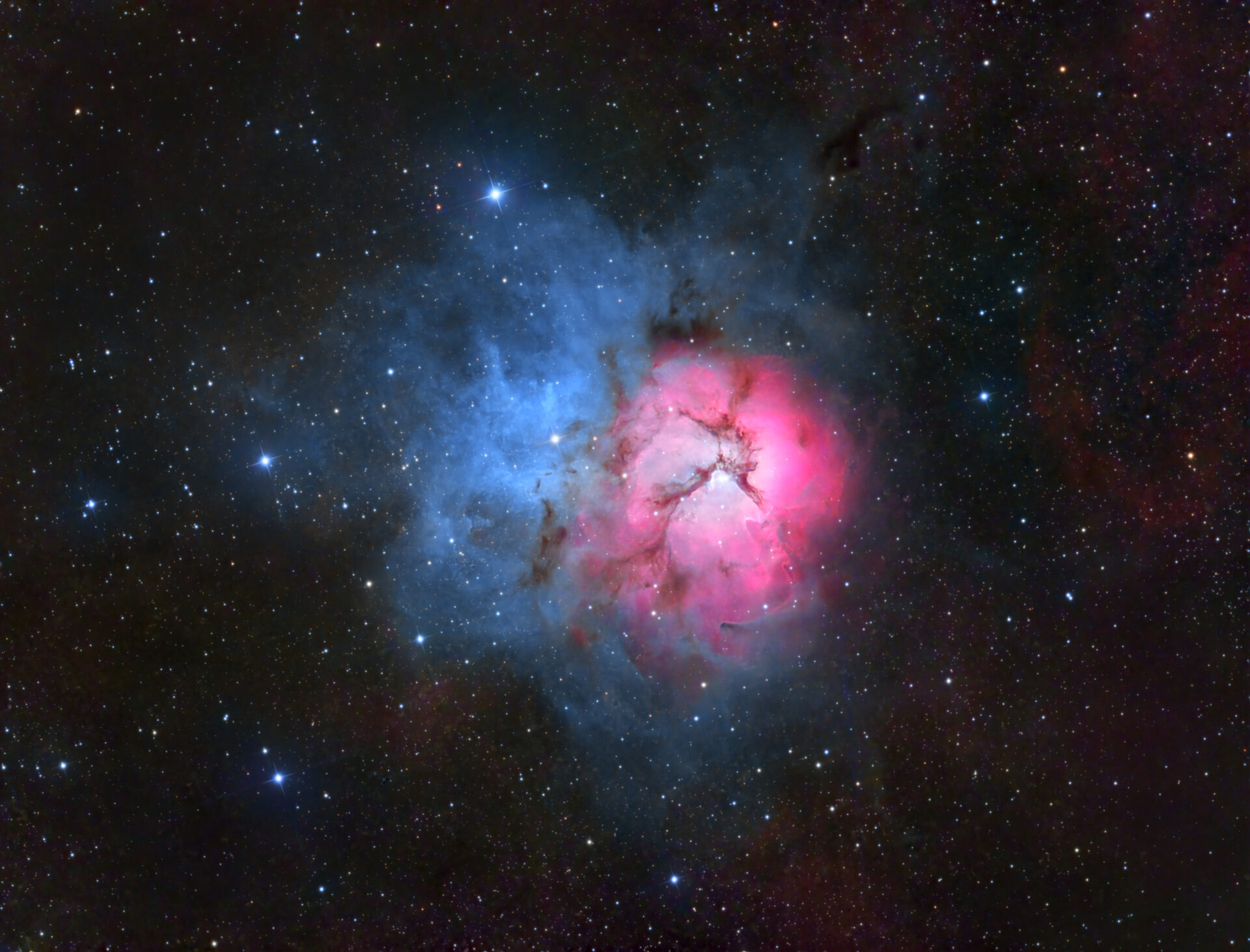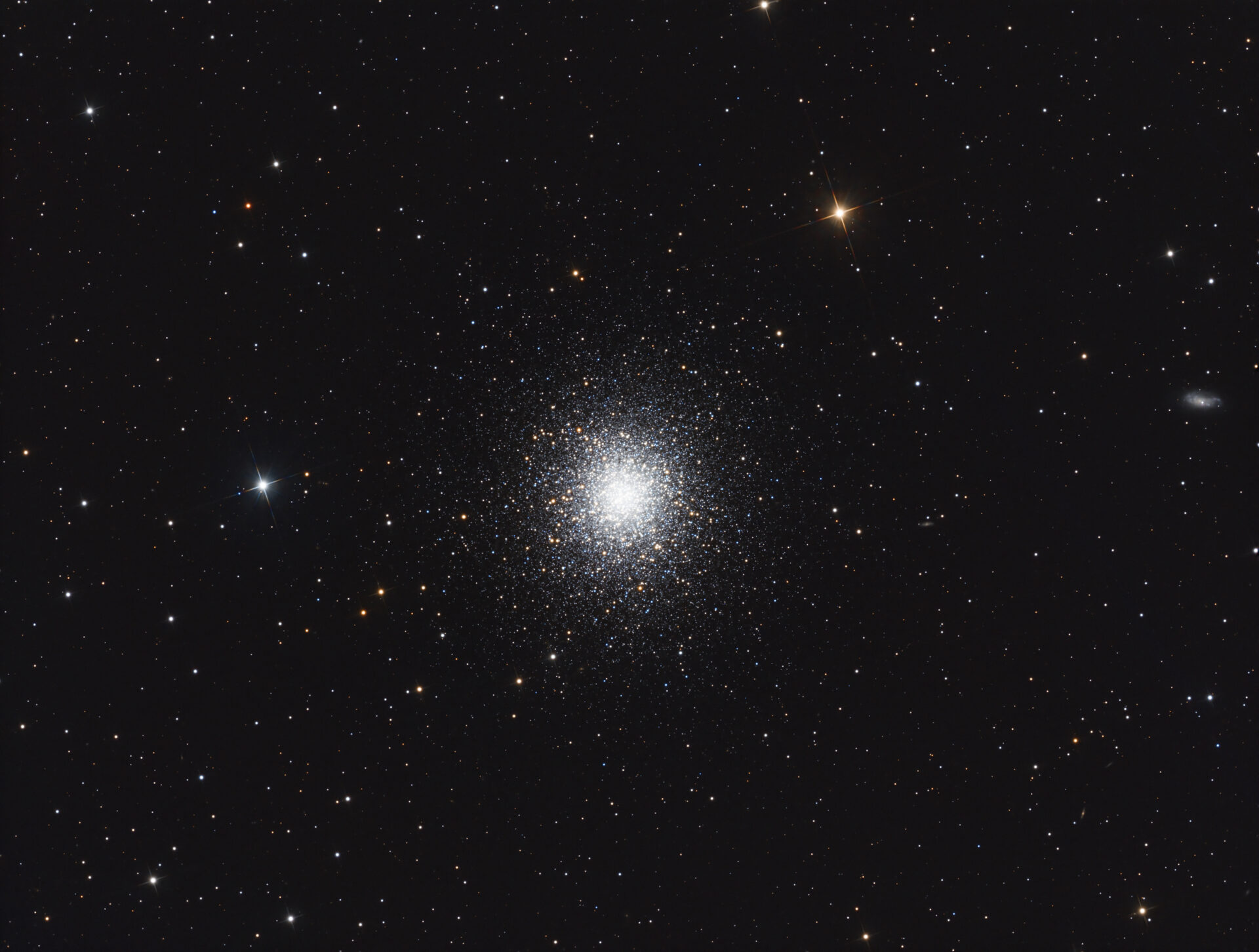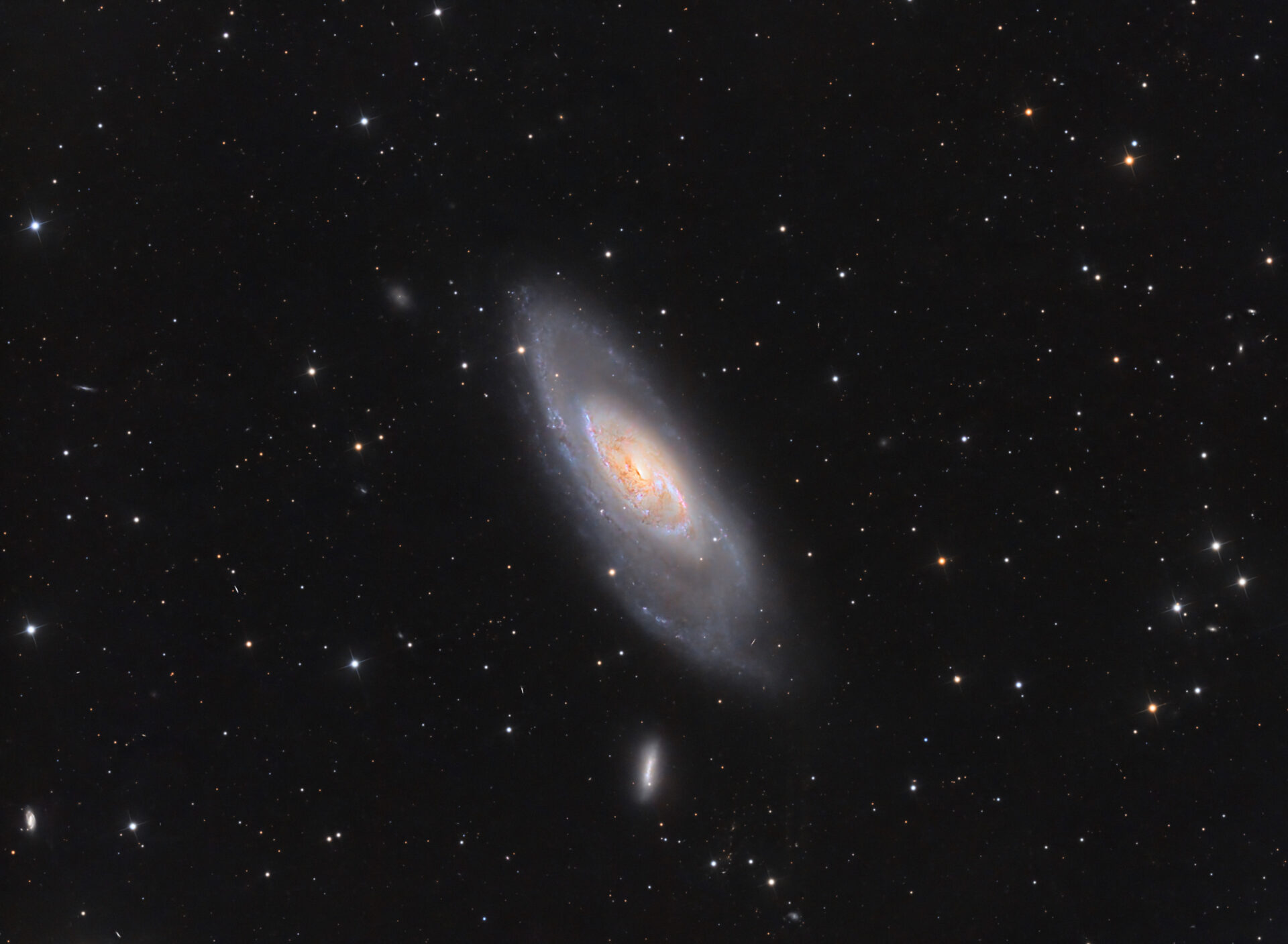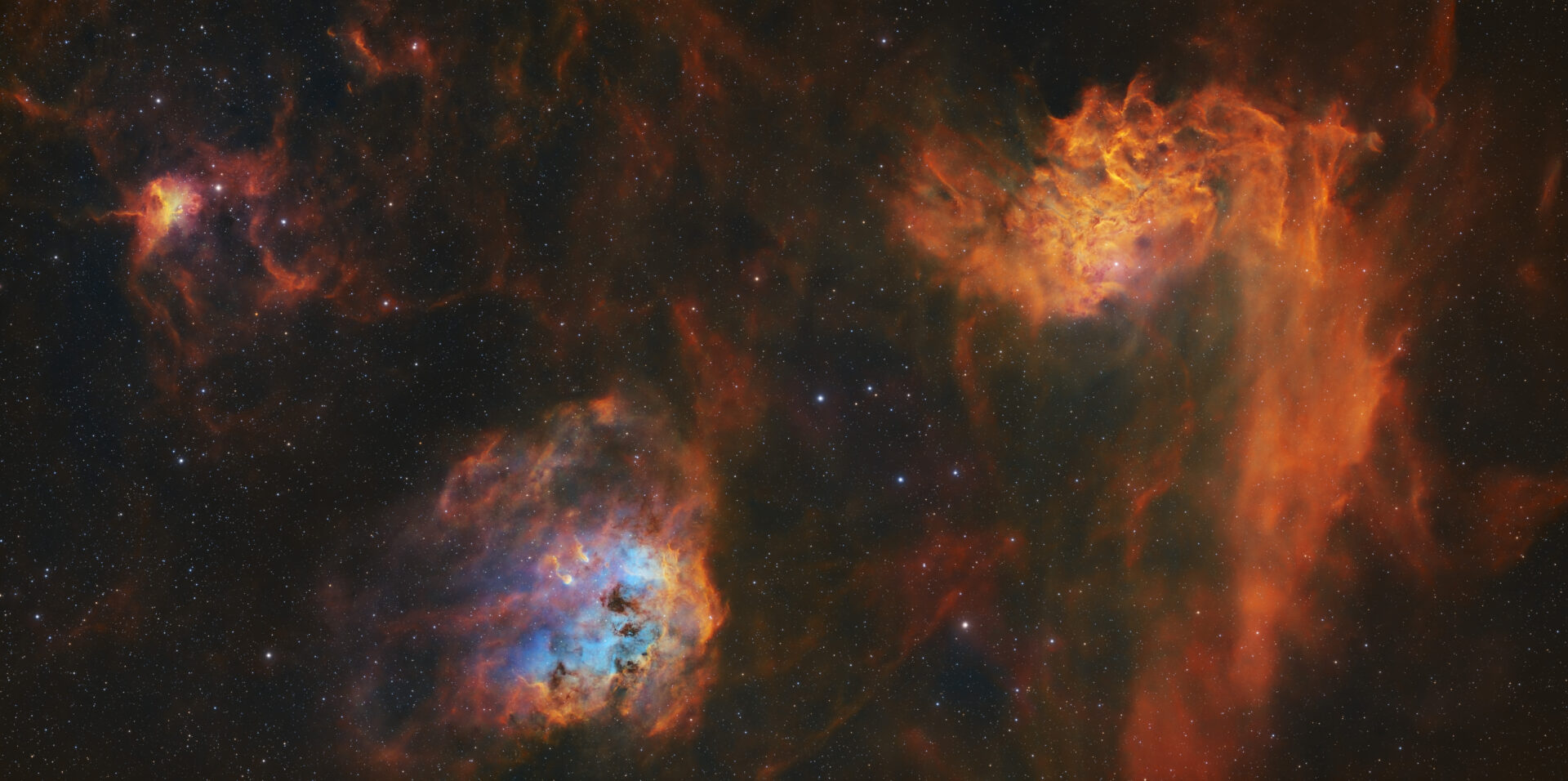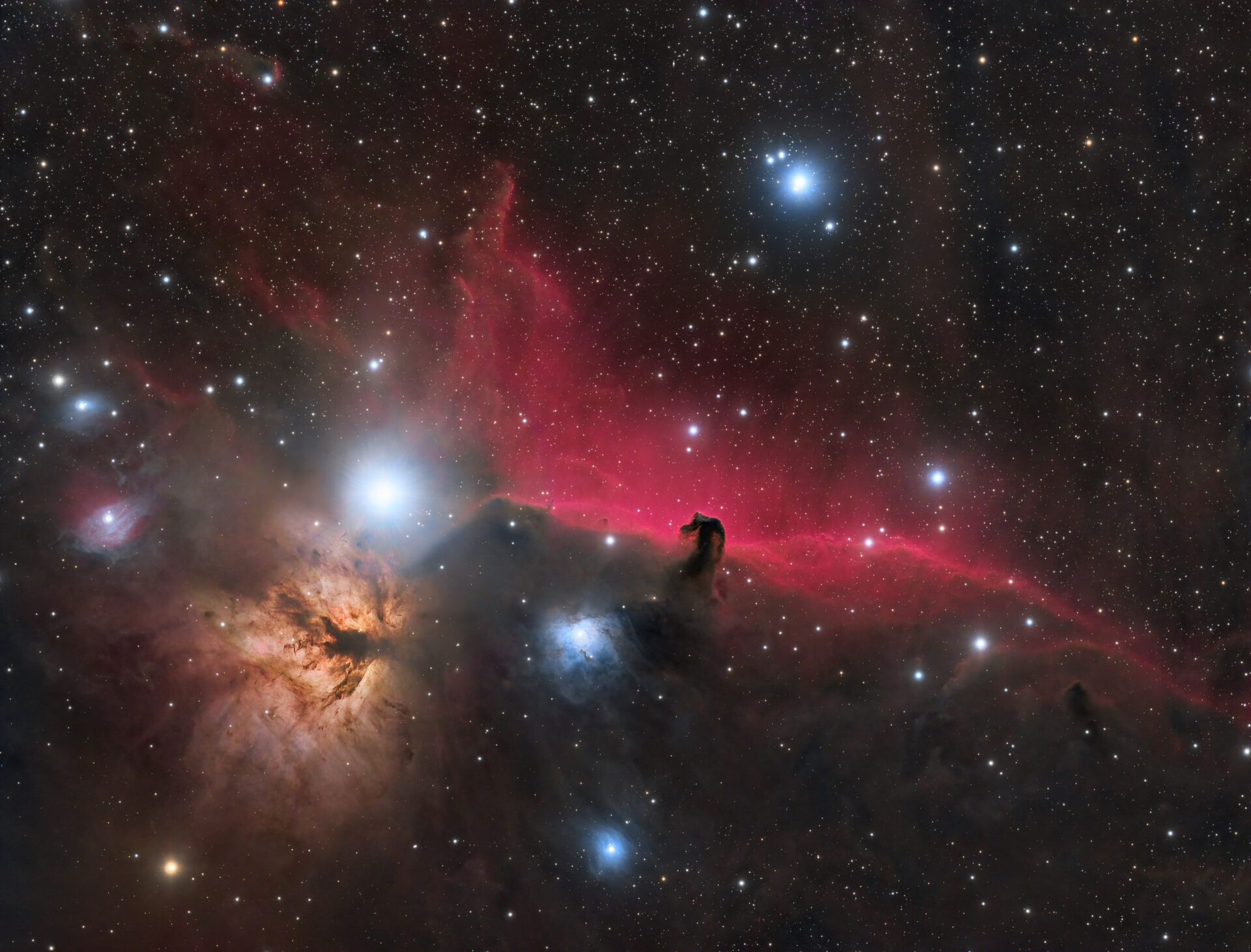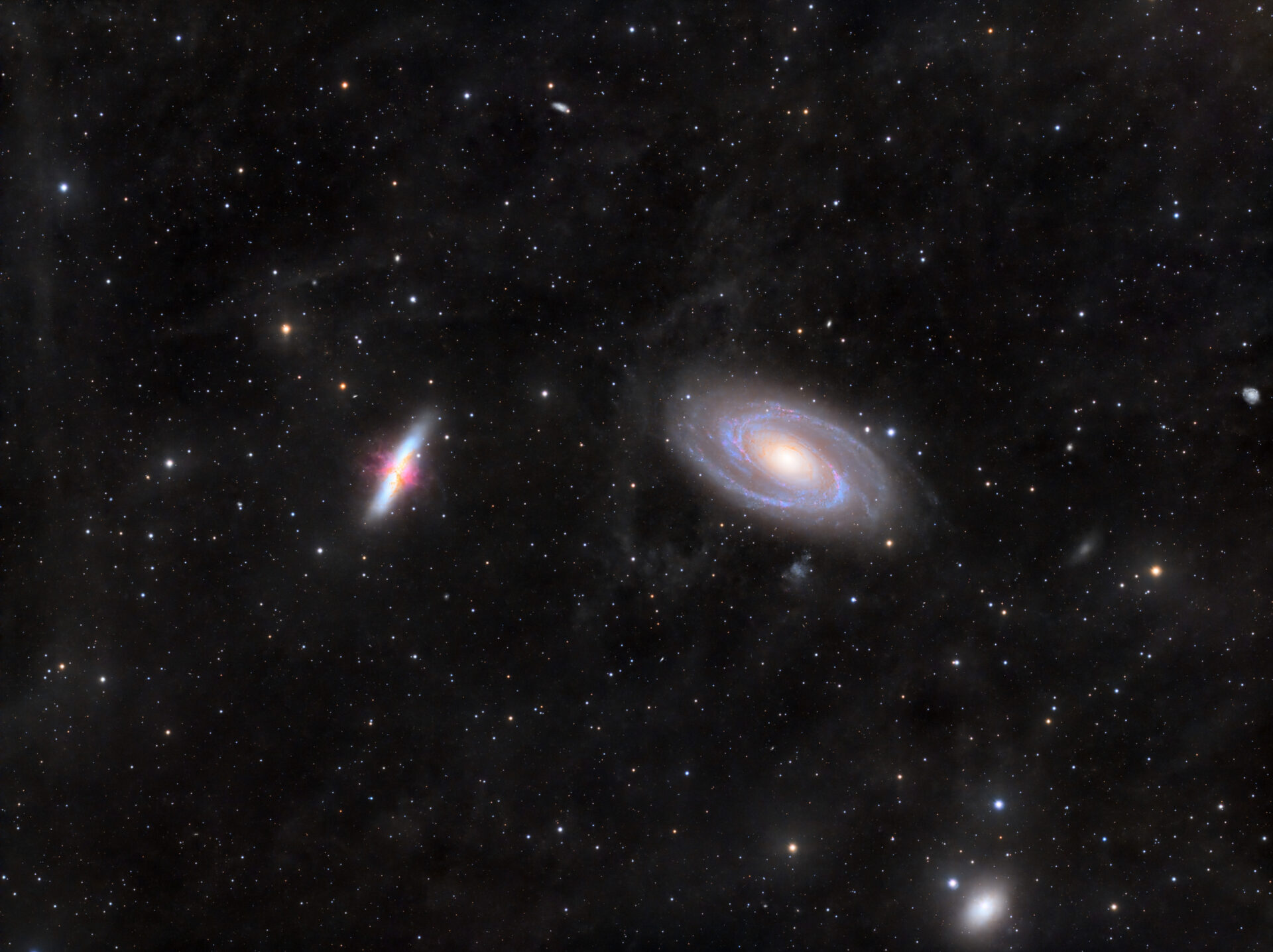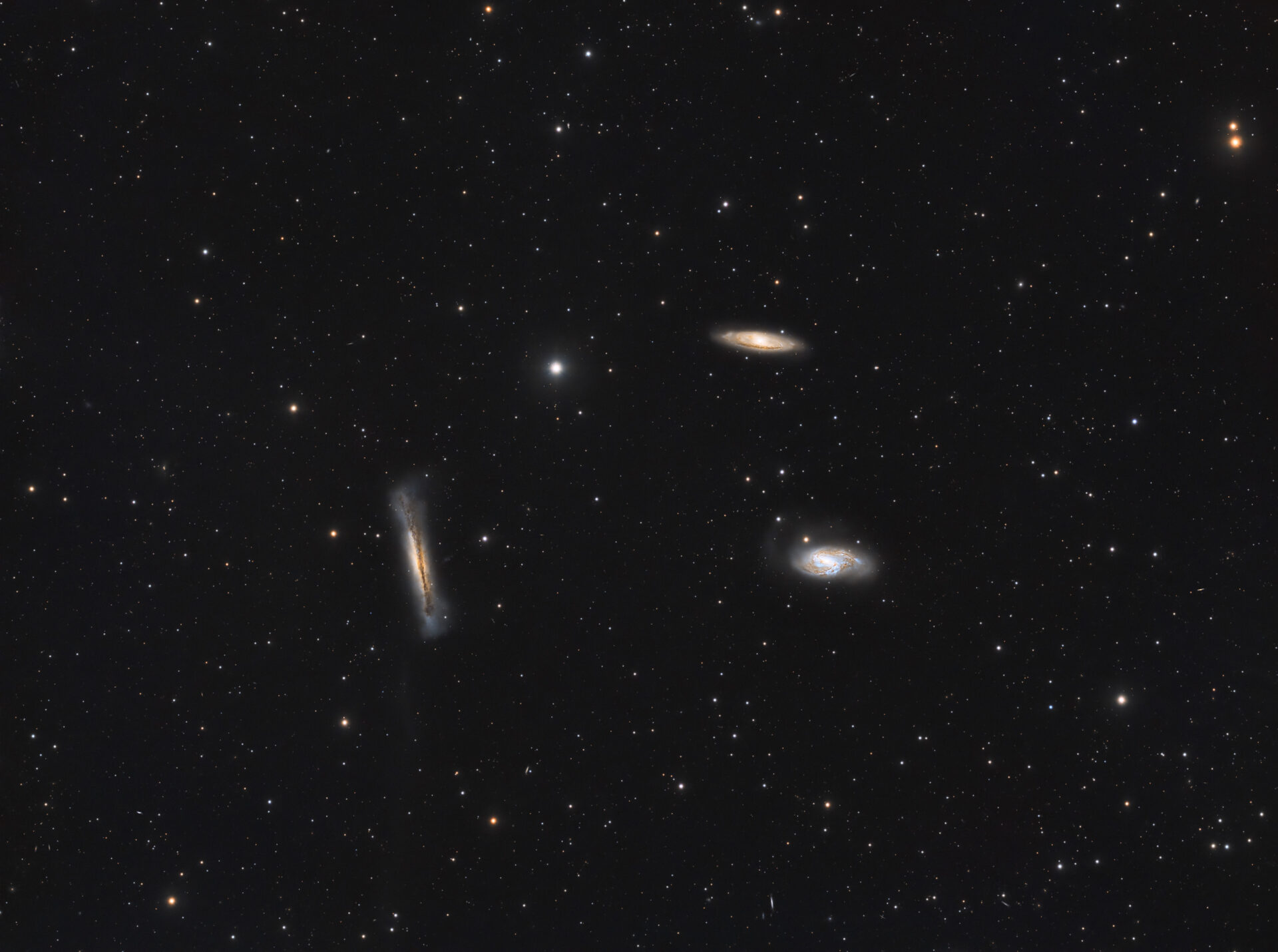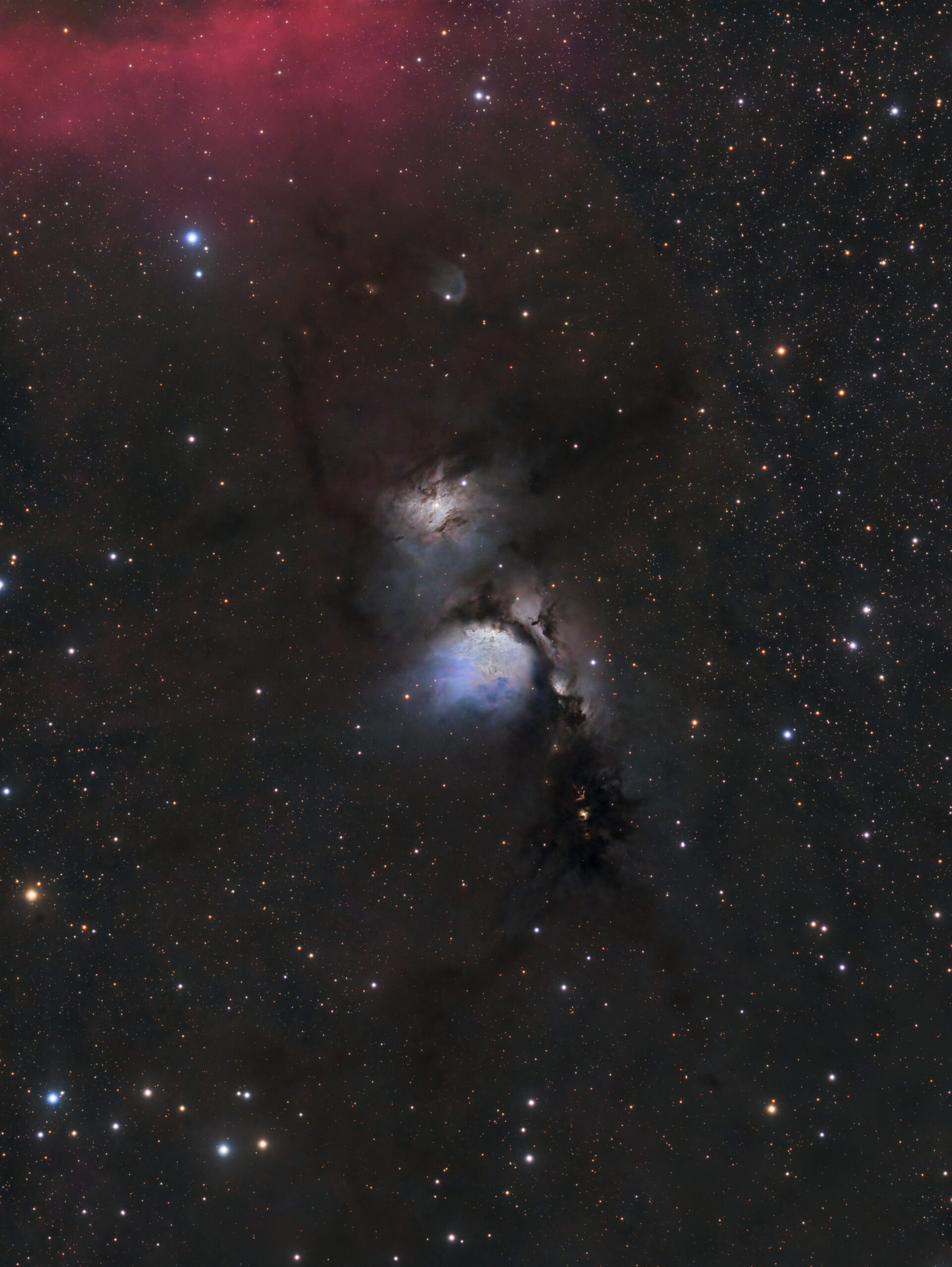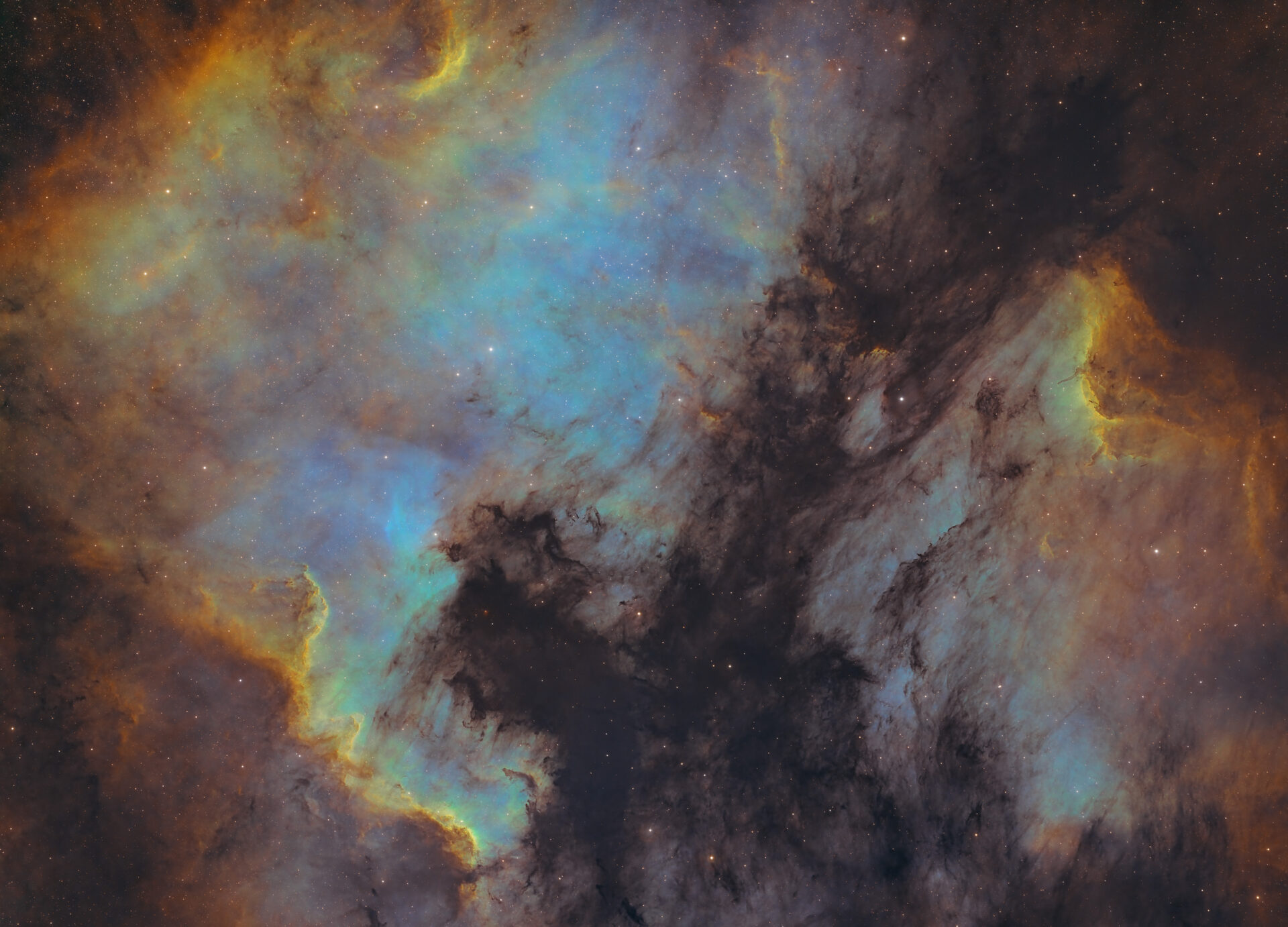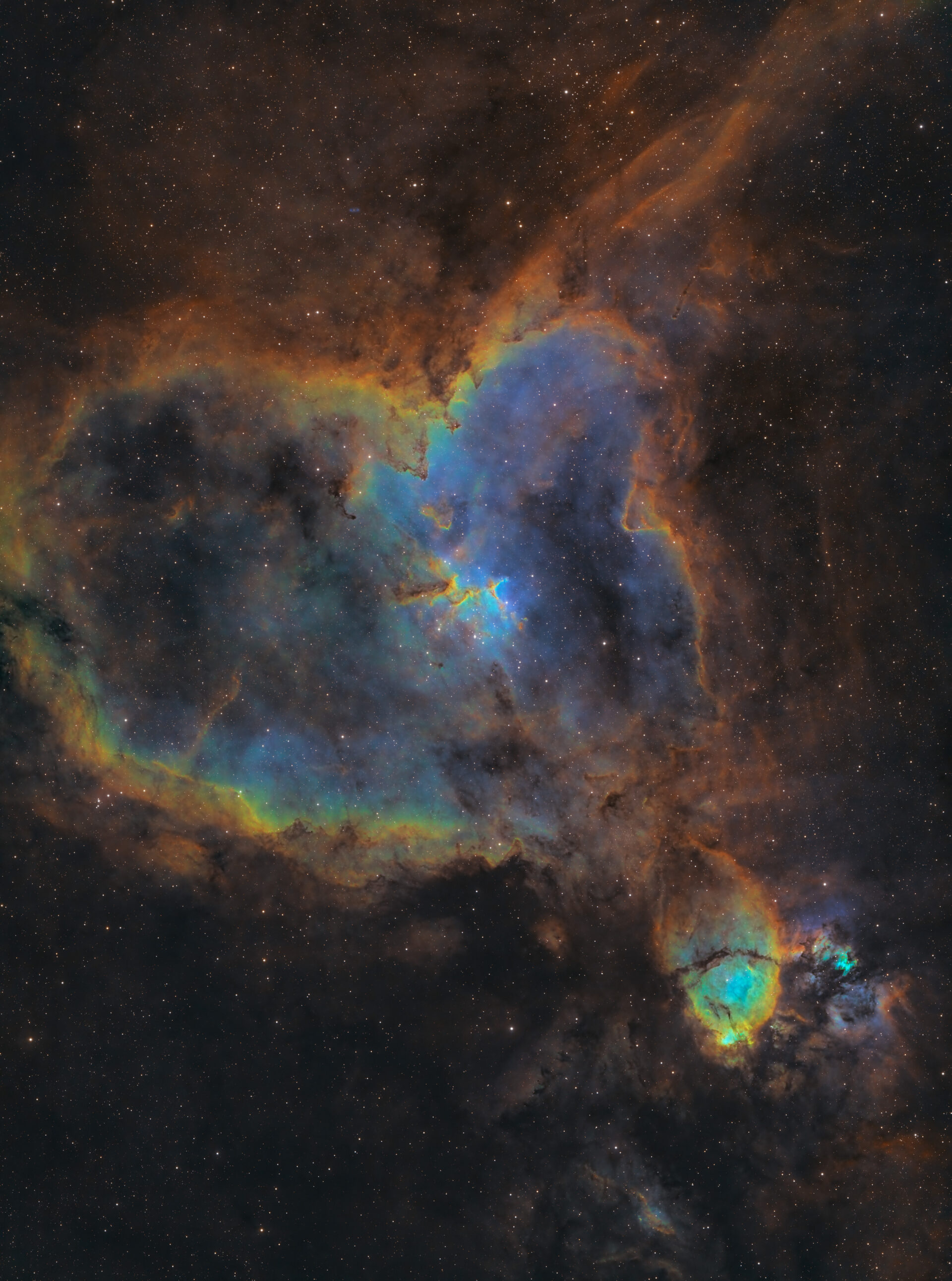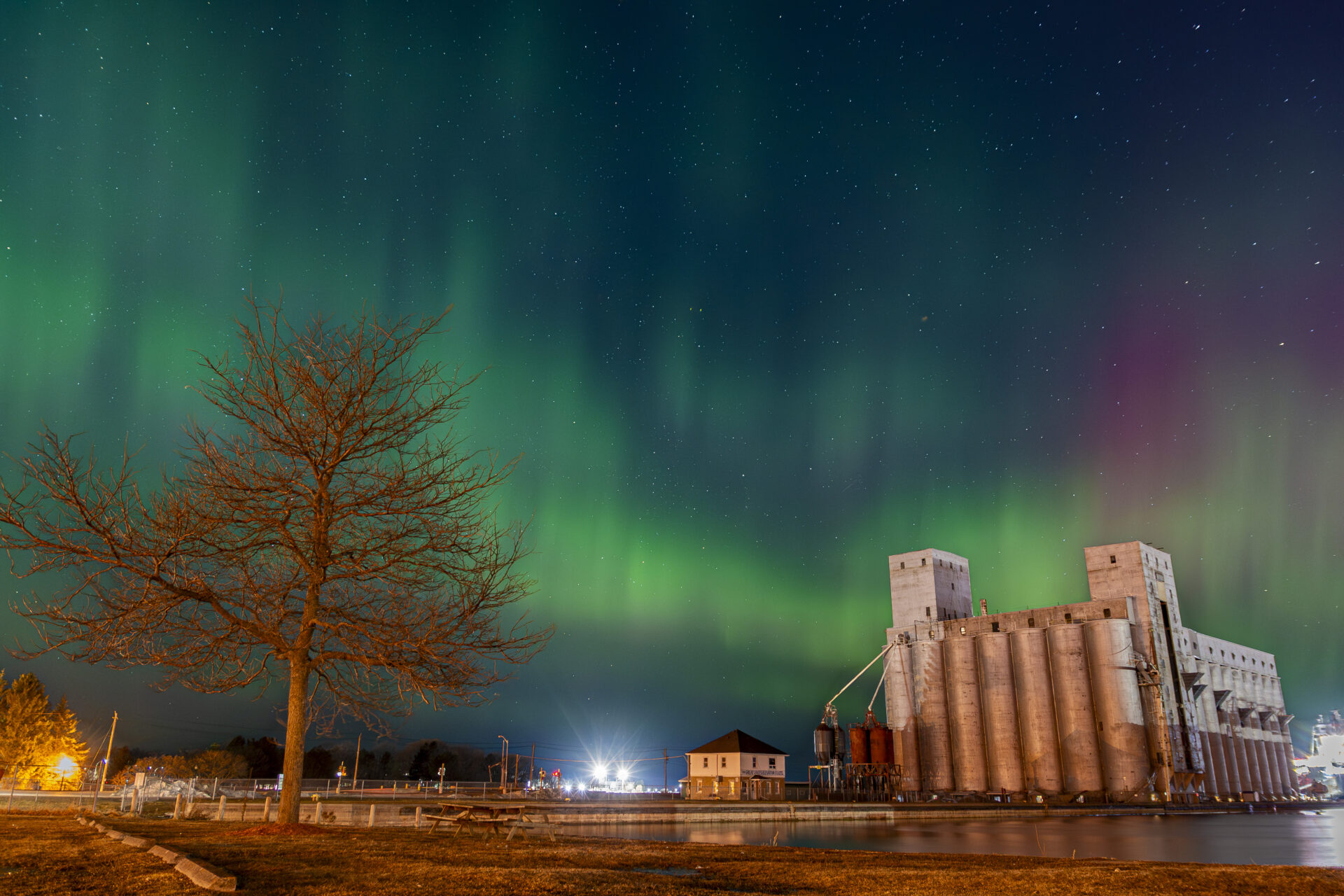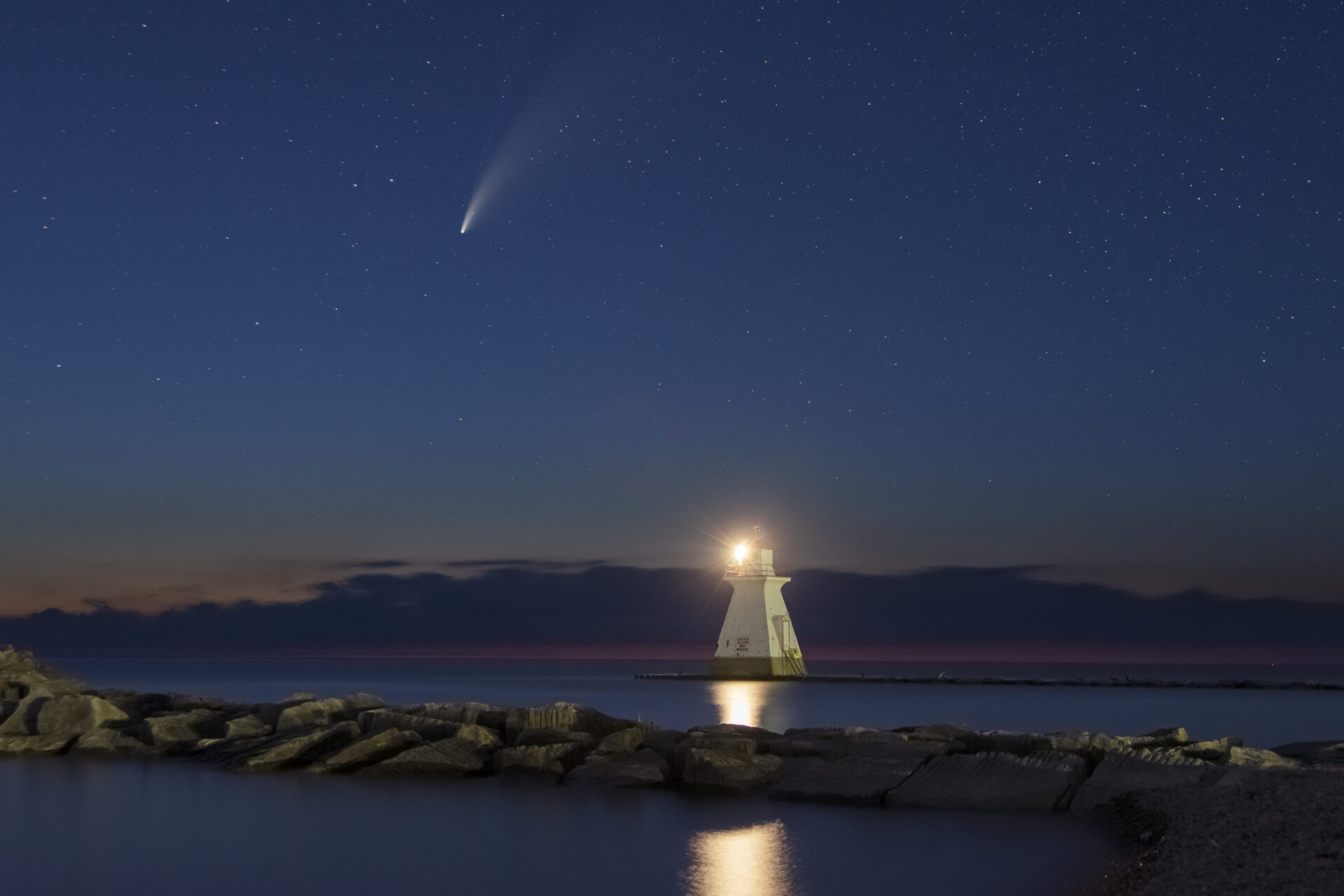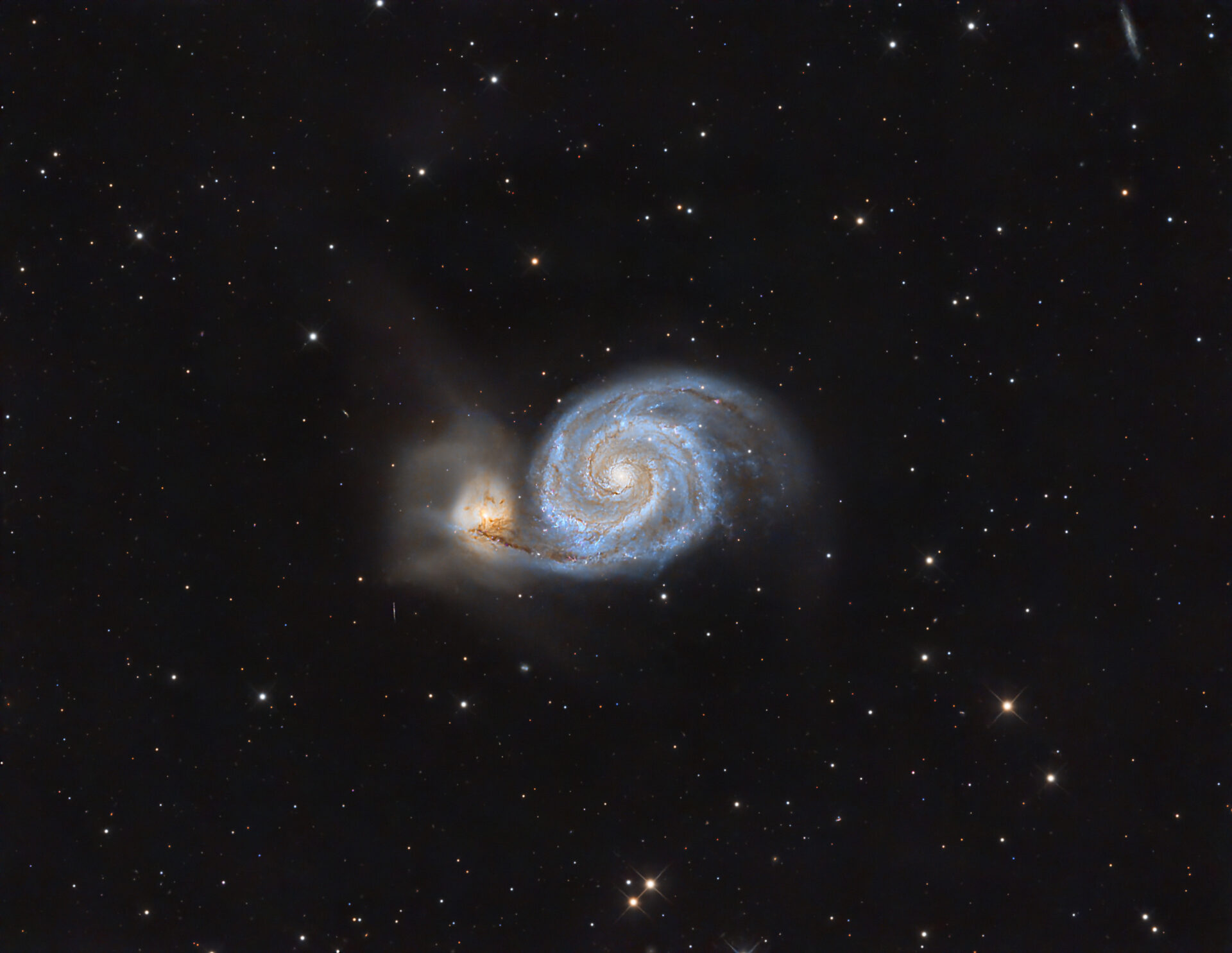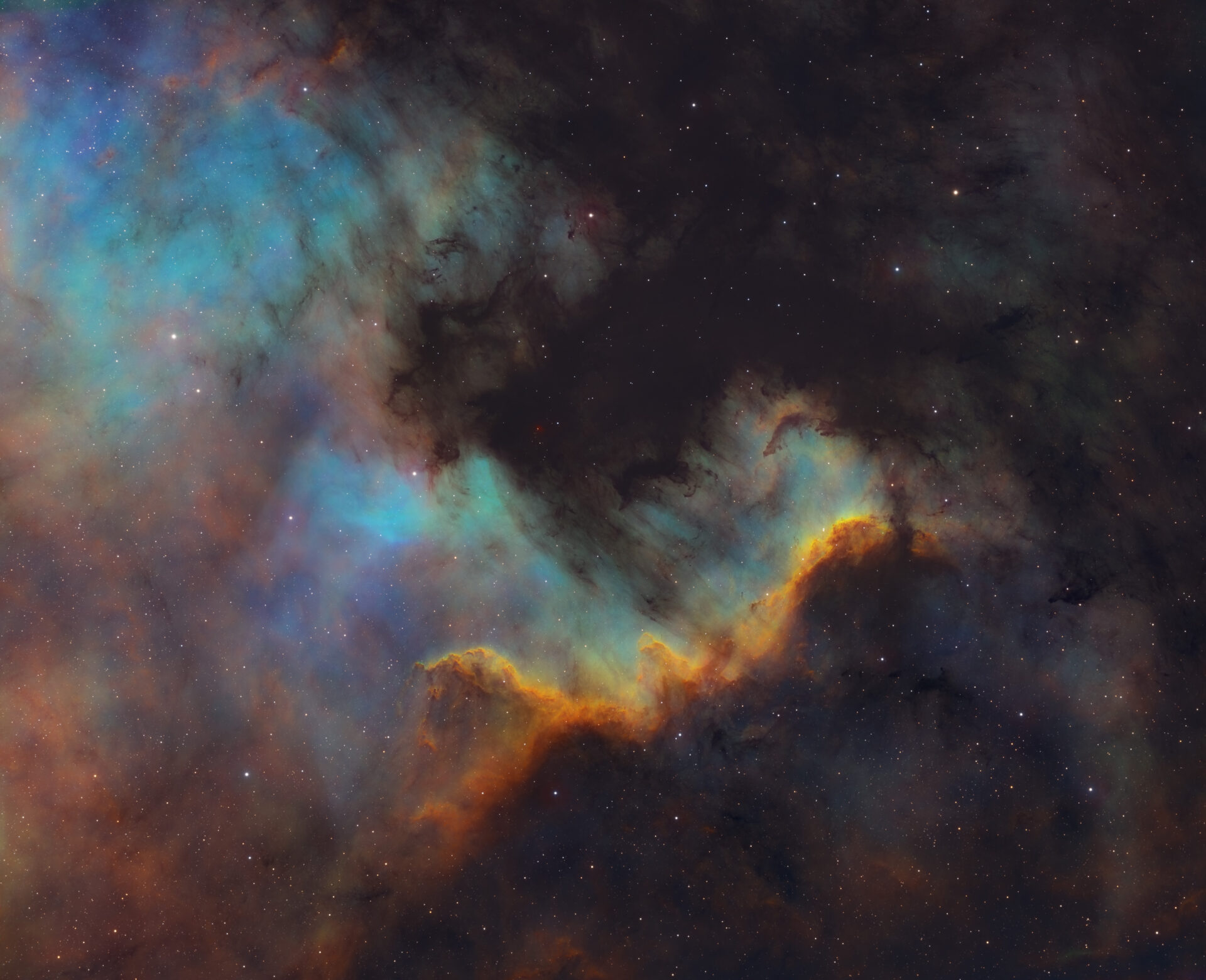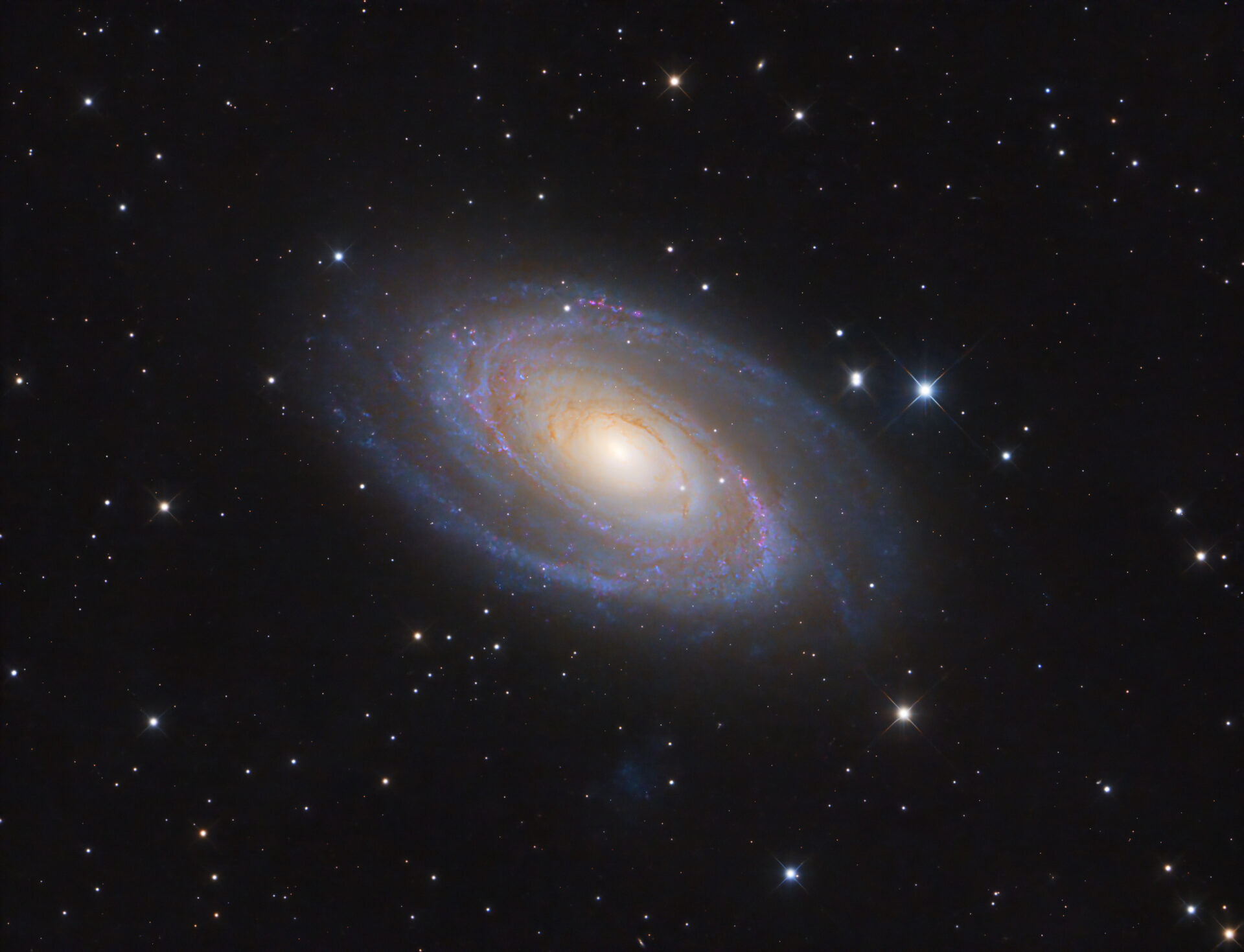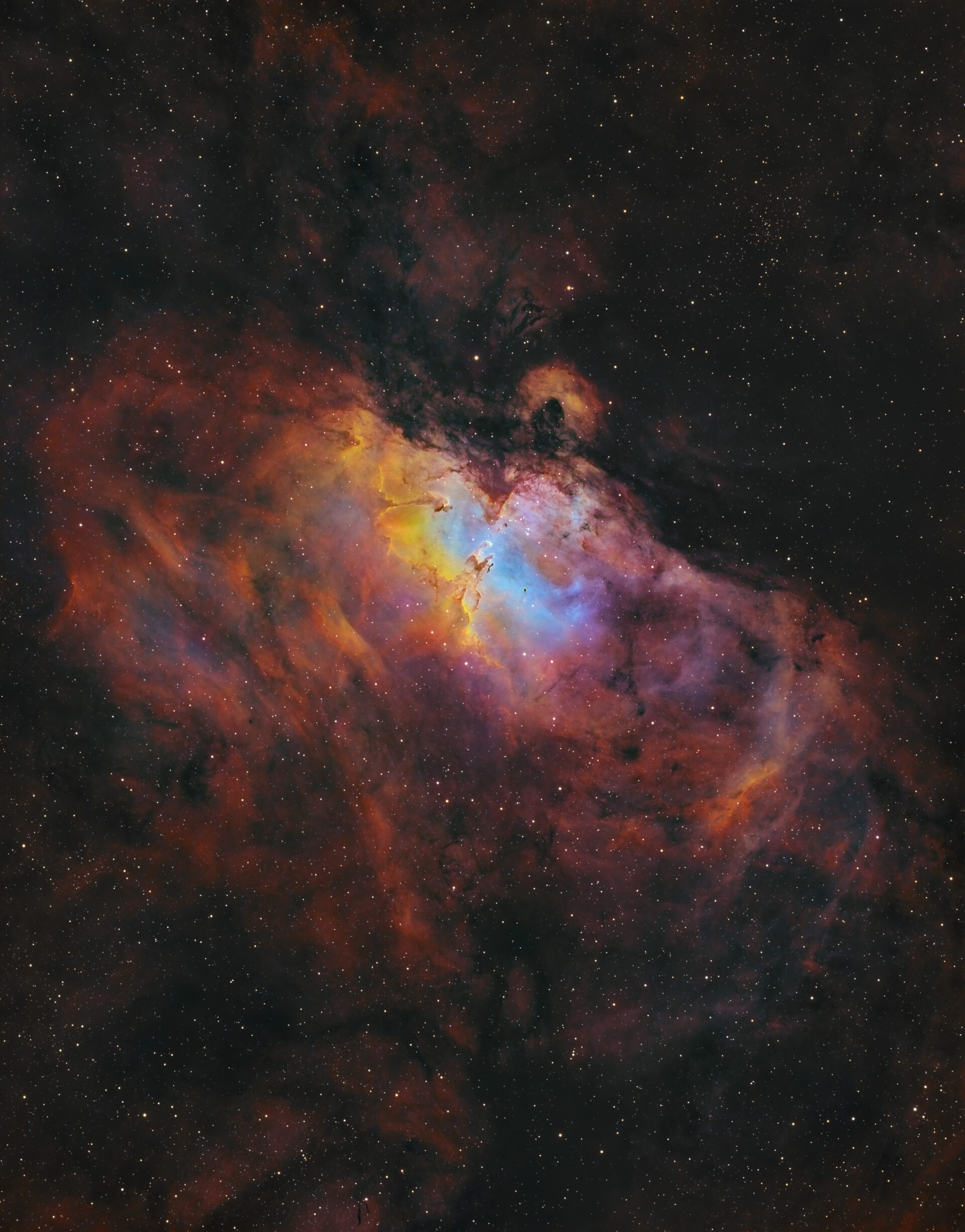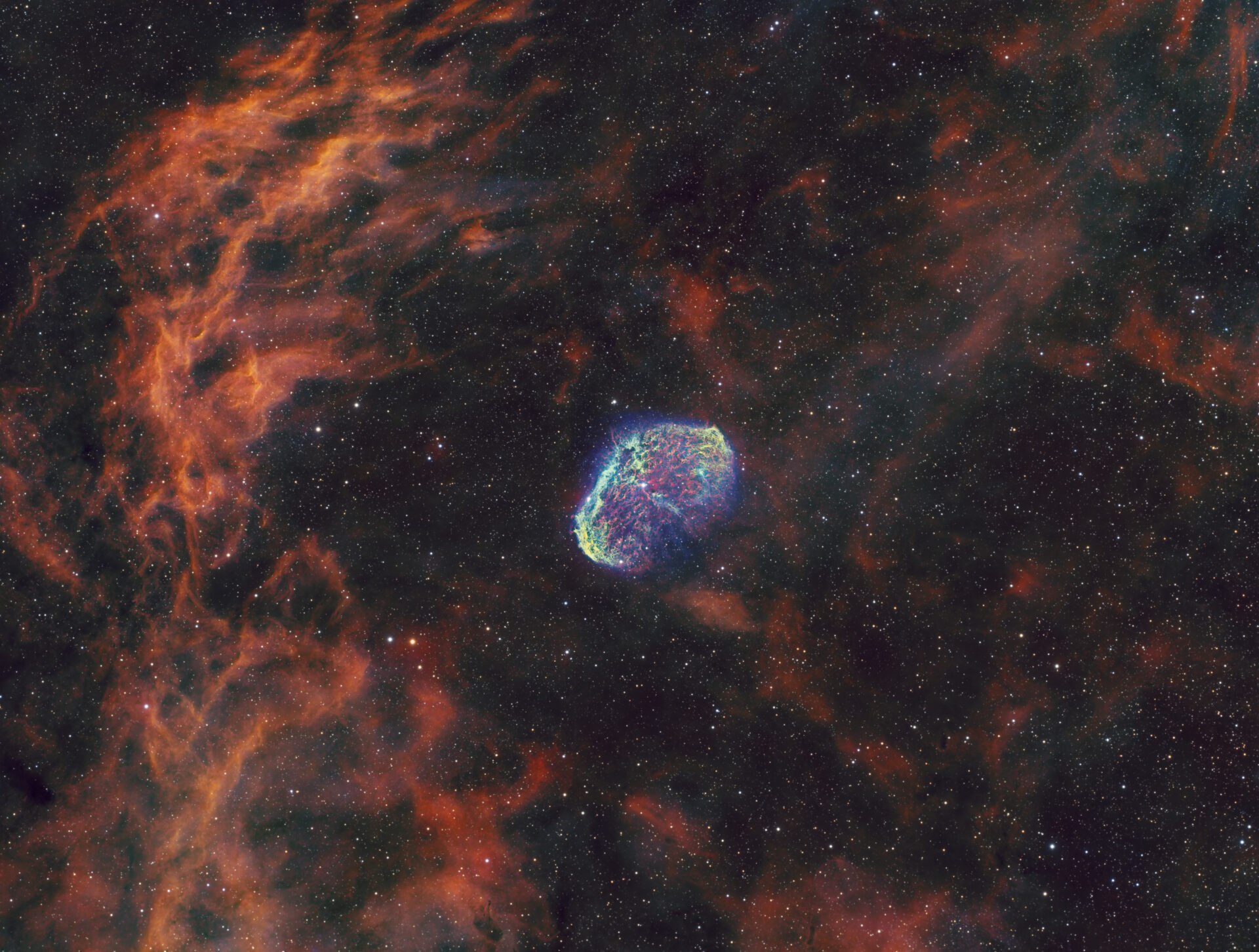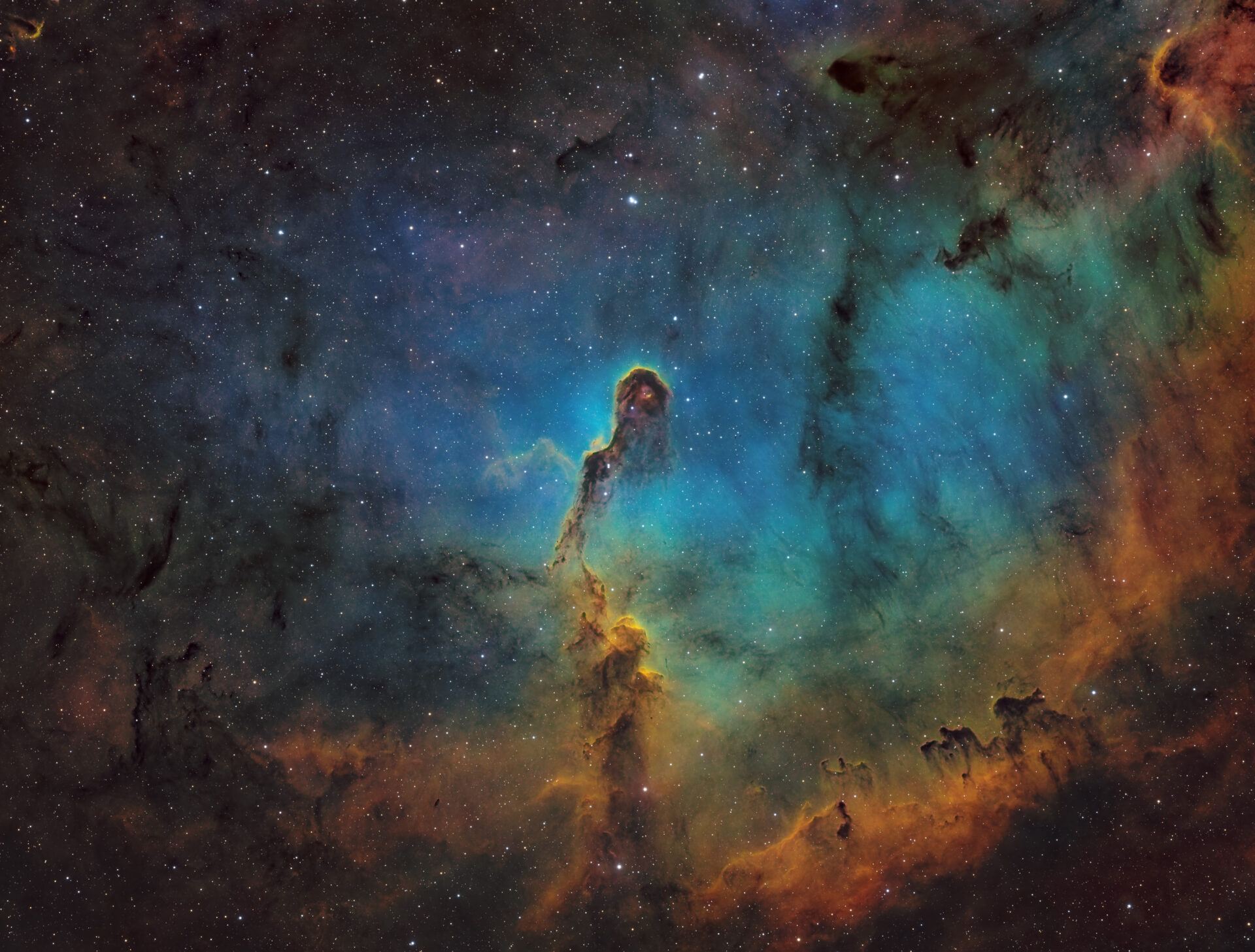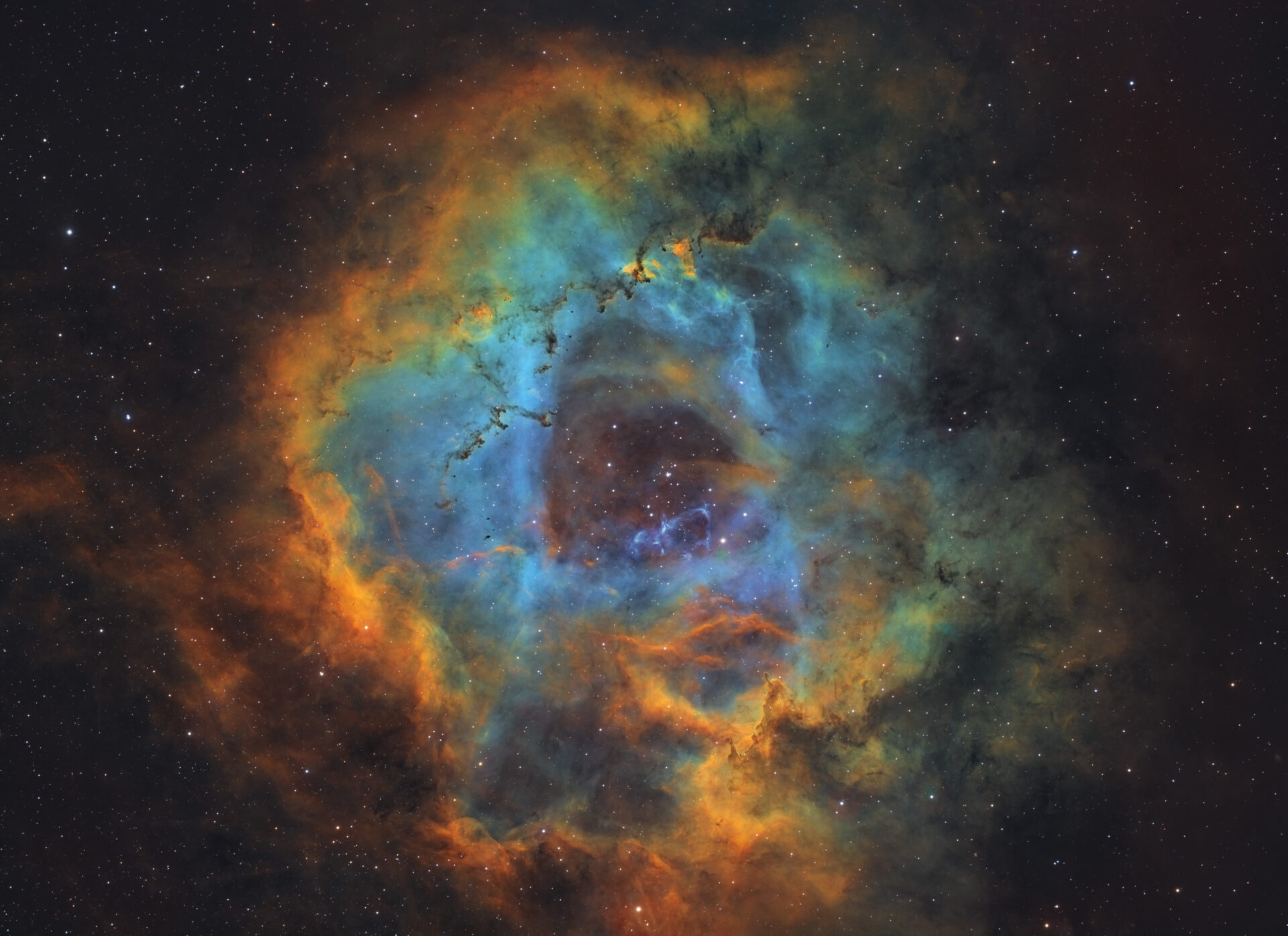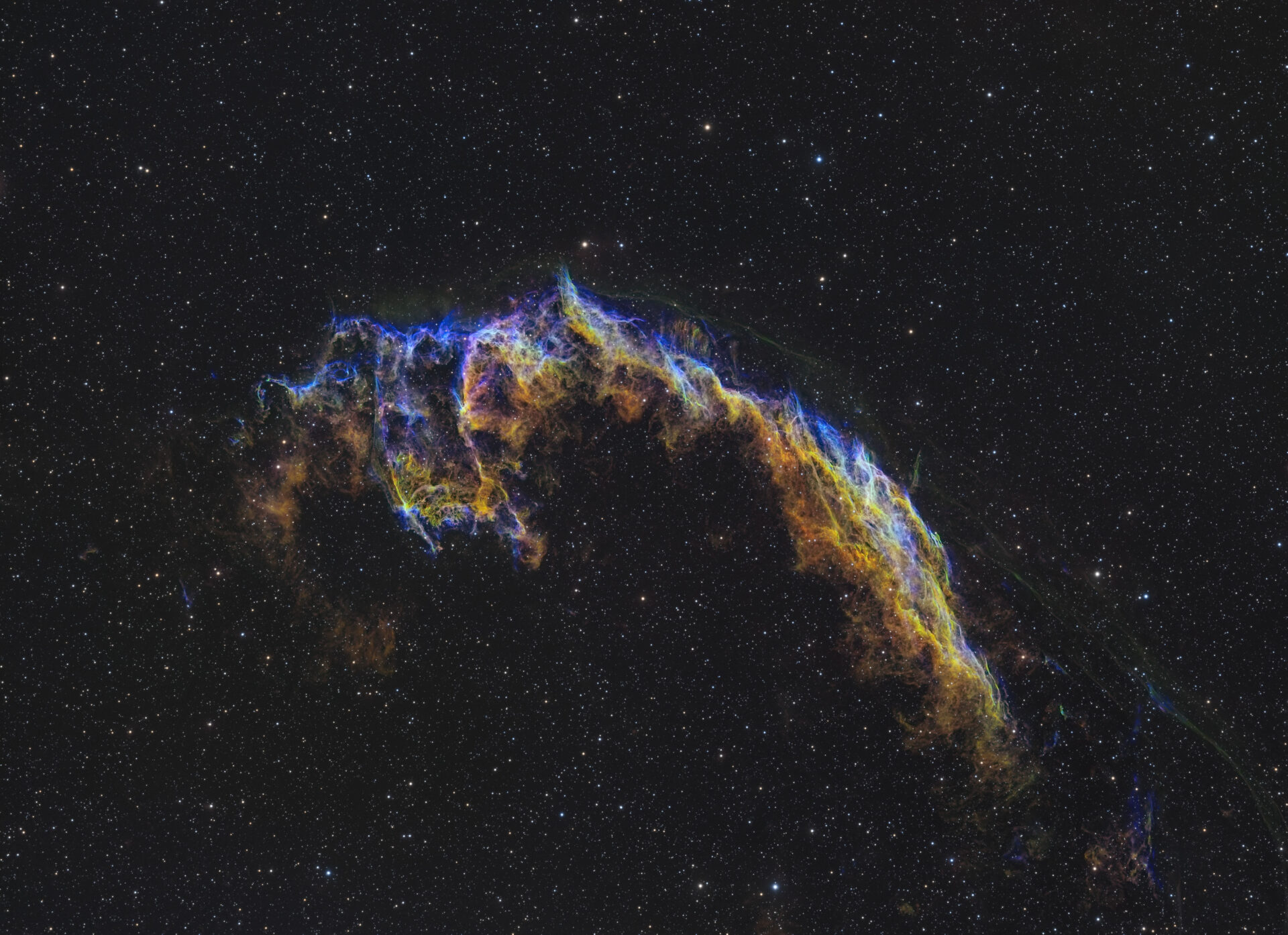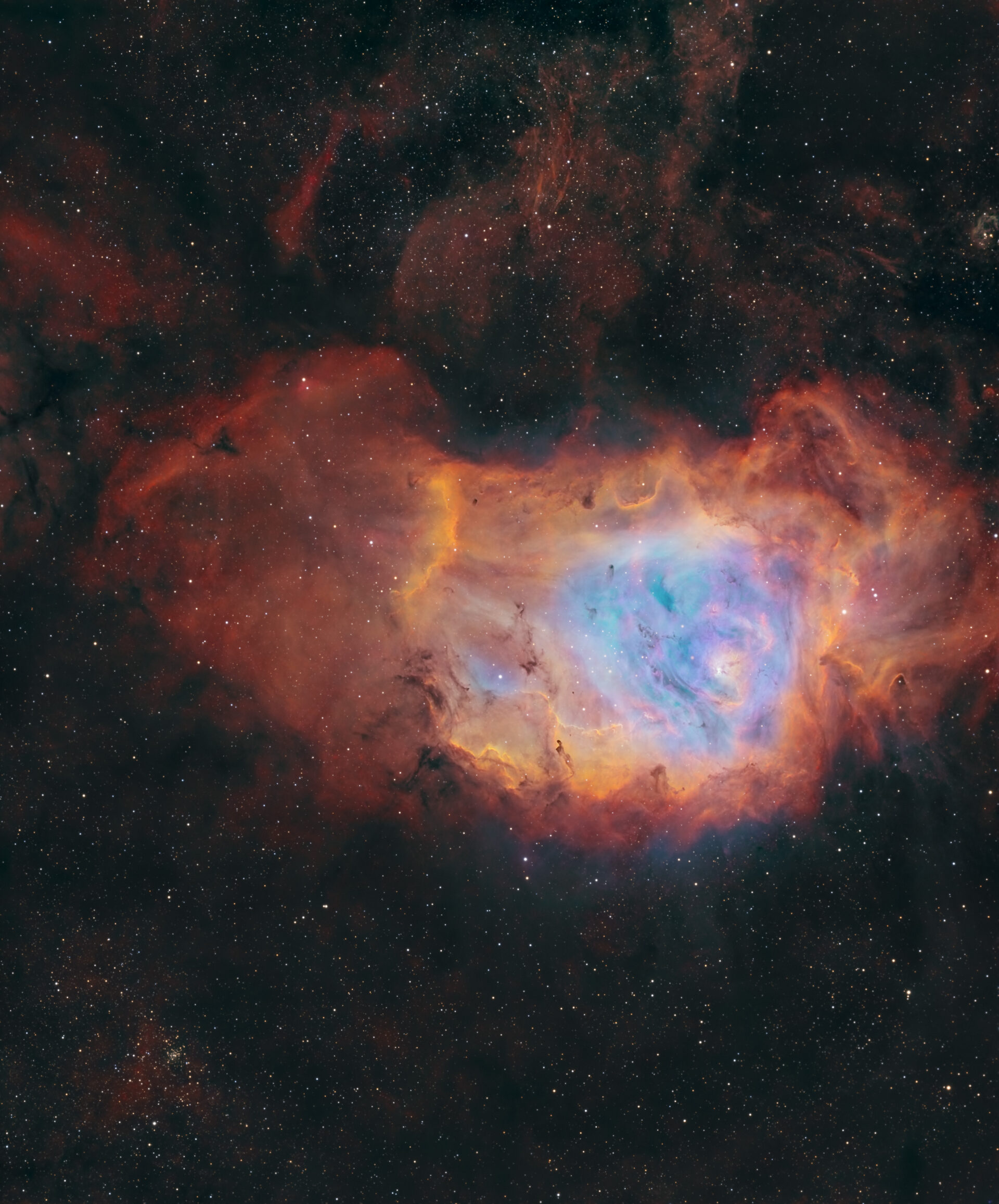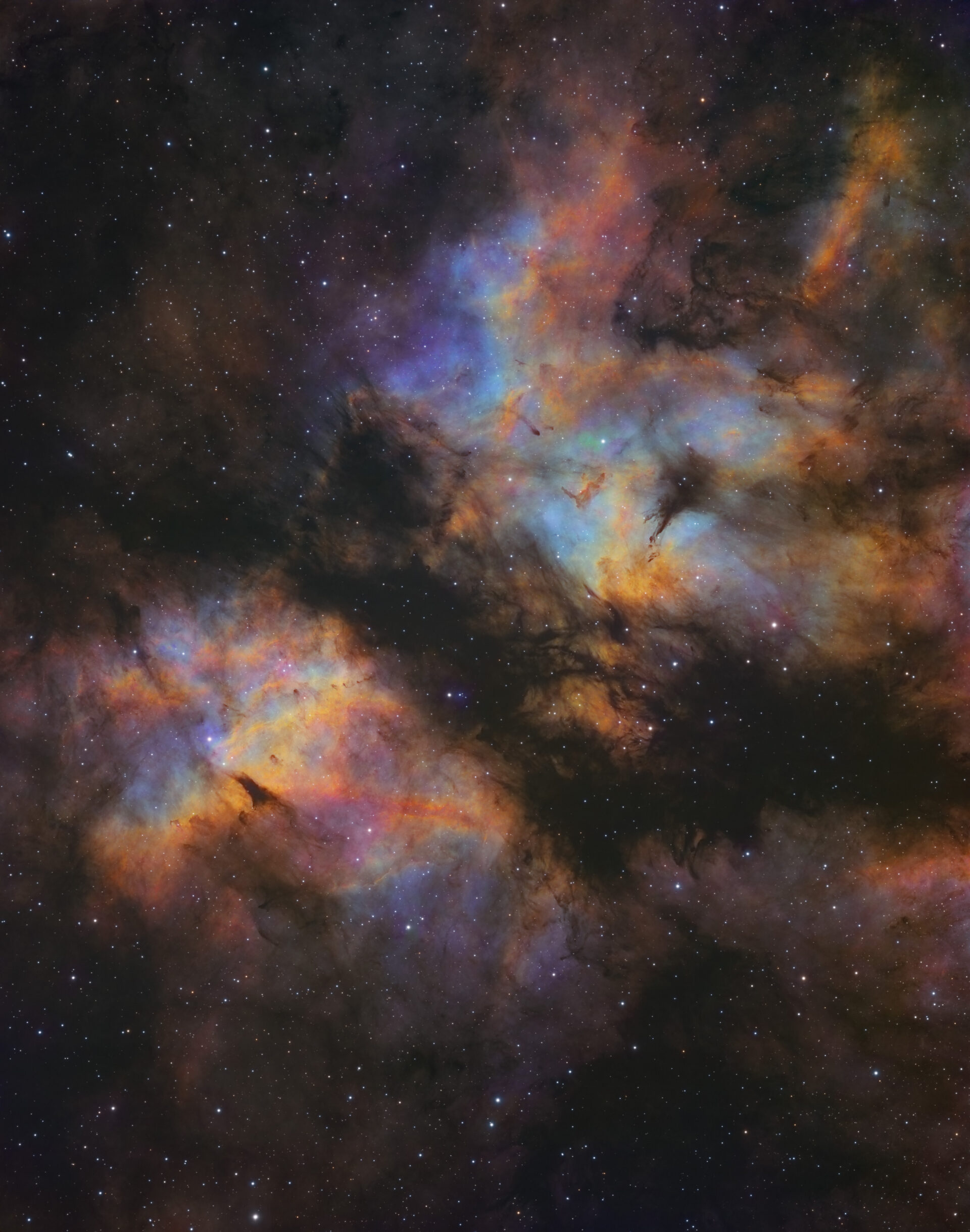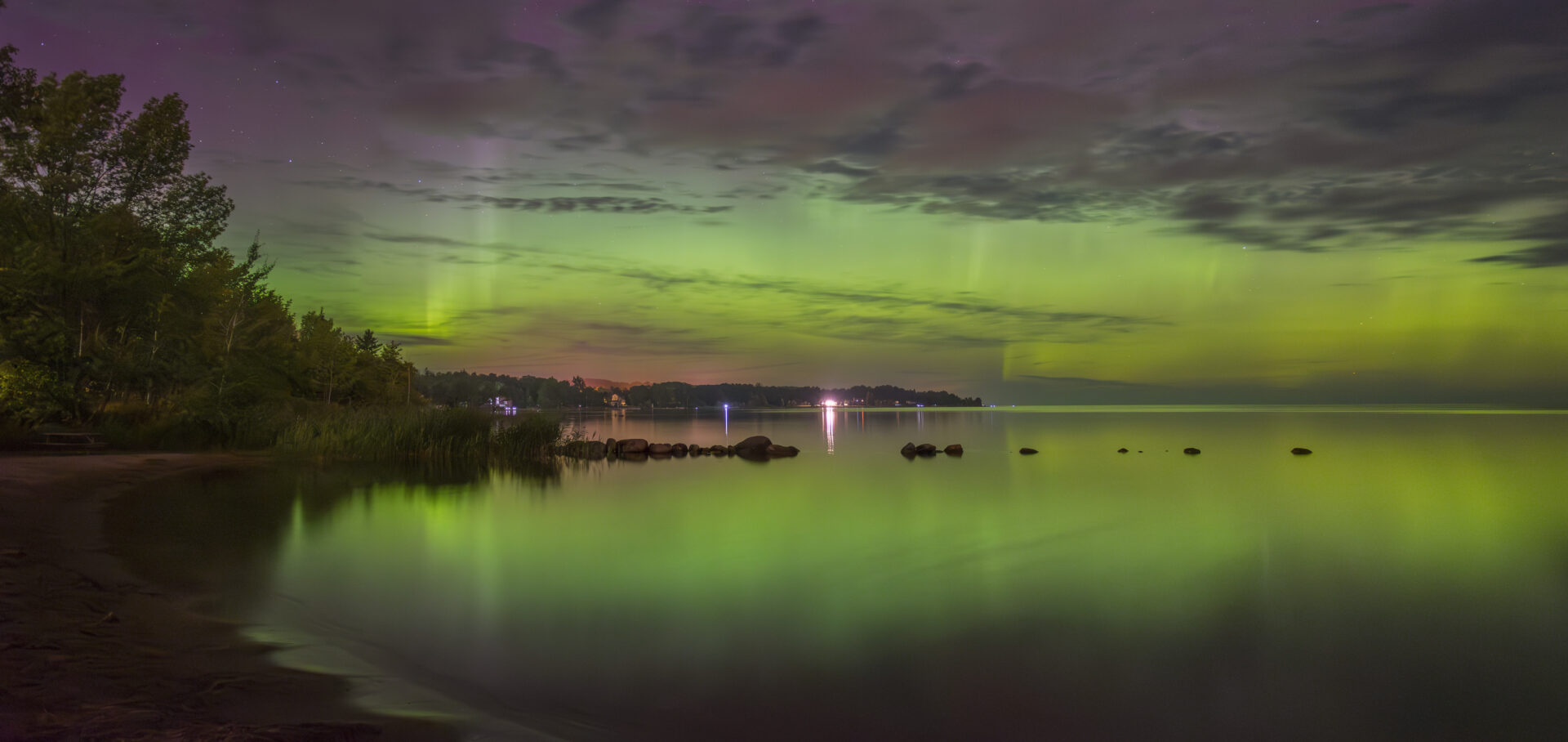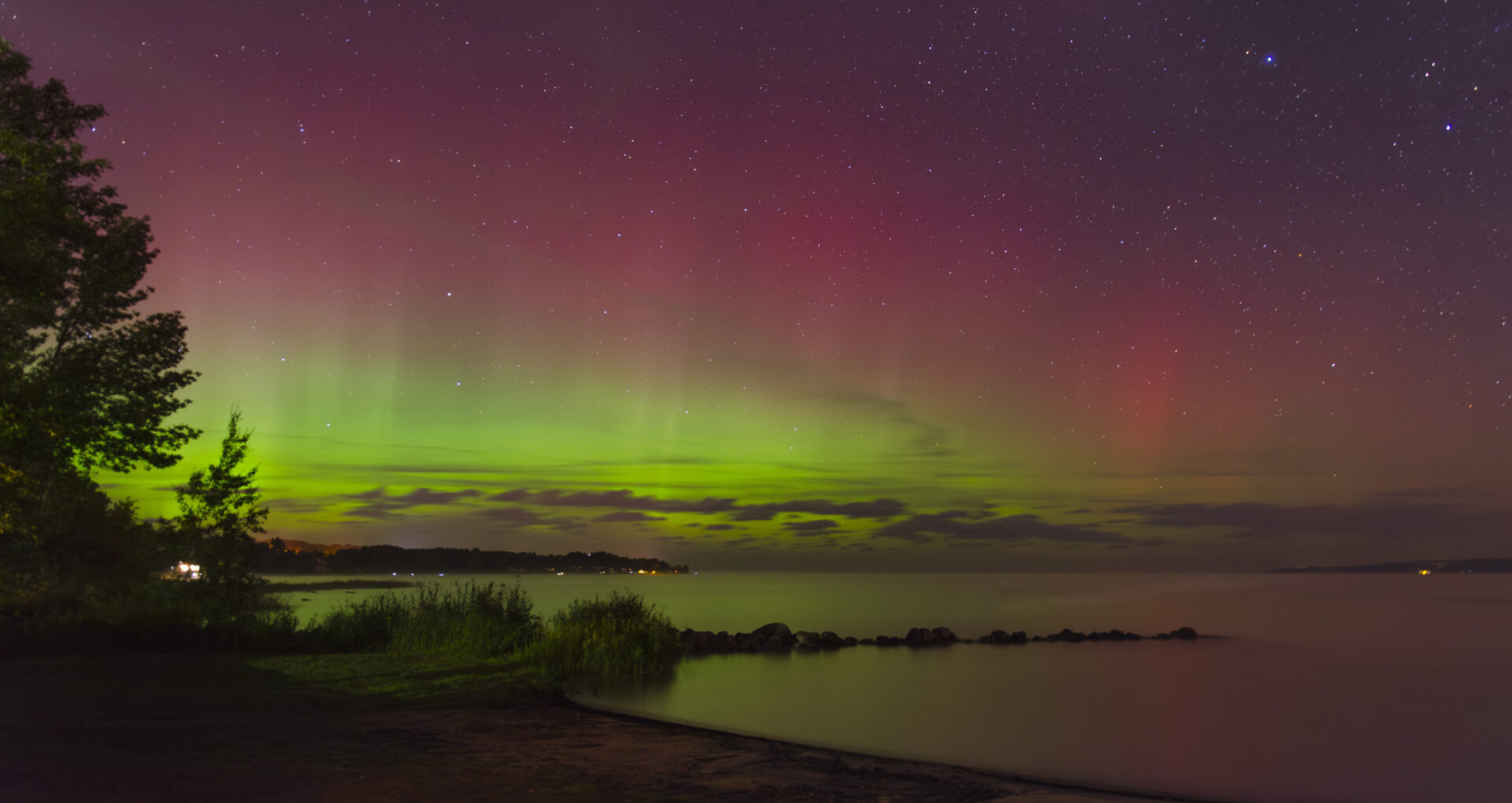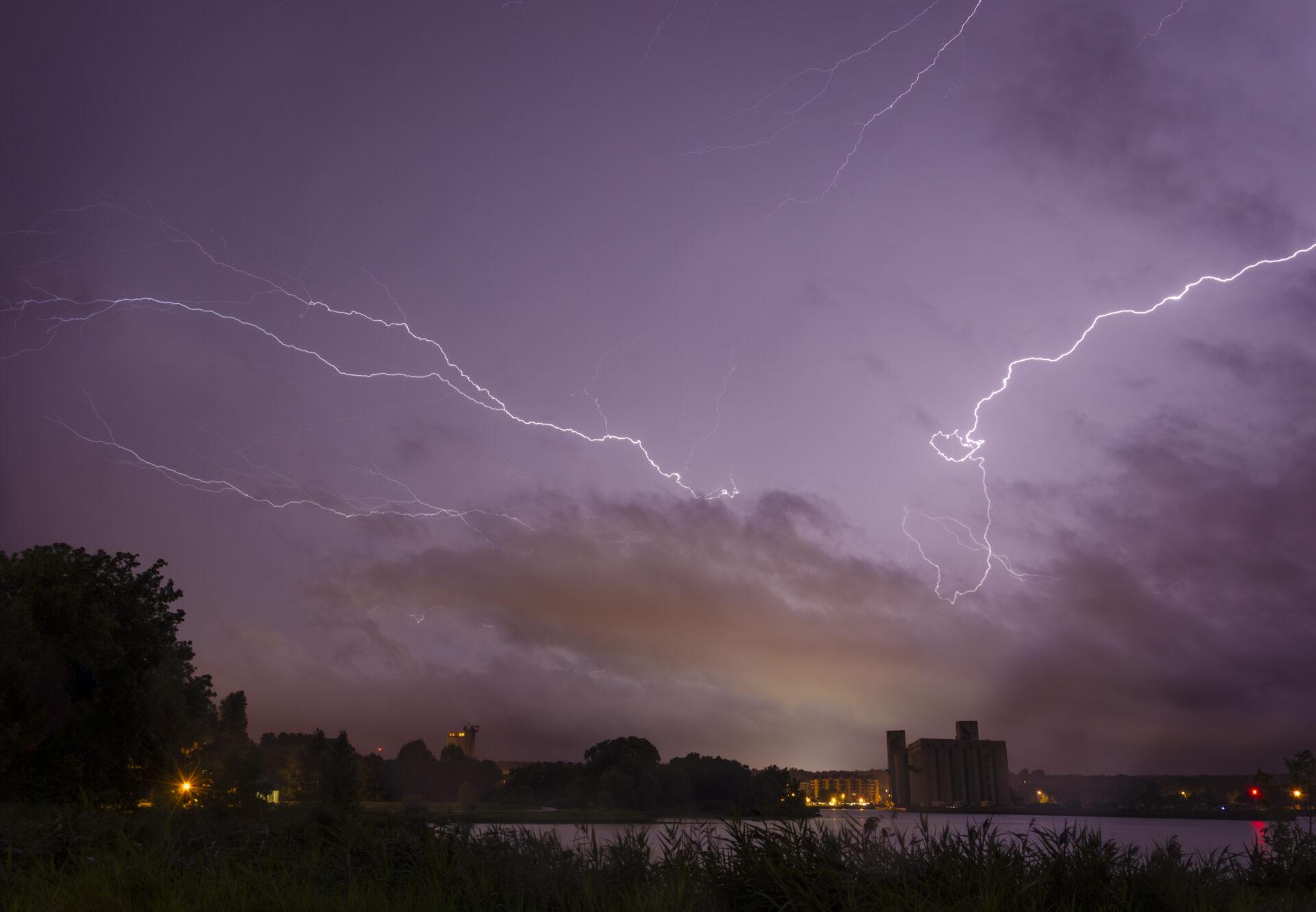Comet C/2023 A3 (Tsuchinshan–ATLAS) – A Closer Look
Comet C/2023 A3 (Tsuchinshan–ATLAS) on its way toward the Sun, showing off a developing tail of dust and gas. This closer view reveals more detail in the coma and tail structure—features shaped by the pressure of sunlight and the solar wind. These short-lived displays are what make comets so fascinating: icy bodies that spend most of their lives far from the Sun, only becoming visible when they swing in close.
Comet C/2023 A3 (Tsuchinshan–ATLAS)
Captured from the shores of Lake Huron, Ontario, this image shows Comet C/2023 A3 (Tsuchinshan–ATLAS) as it passed through the constellation Virgo. Discovered in January 2023 by the Purple Mountain Observatory and the ATLAS survey.
Kemble Tree Aurora Vertorama
This vertorama captures the aurora borealis over Kemble, Ontario, with the solitary tree beneath the vibrant green and purple hues of the Northern Lights.
Kemble Barn Aurora
This image captures the aurora borealis over Kemble, Ontario, with a barn beneath the vibrant Northern Lights.
Kemble Barn & Tree Aurora Panorama
This panoramic shot captures the aurora borealis over Kemble, Ontario, including both the barn and tree beneath the vibrant Northern Lights.
Oliphant Fen Aurora
This image captures the aurora borealis over Oliphant Fen on the Bruce Peninsula in Ontario, Canada.
Triangulum Galaxy (M33)
This image features the Triangulum Galaxy (M33), a barred spiral galaxy located approximately 3 million light-years away in the constellation Triangulum. M33 is the third-largest member of our Local Group of galaxies, following the Milky Way and Andromeda. It spans about 60,000 light-years in diameter and contains several regions of active star formation, including the prominent H II region NGC 604. M33 was likely discovered by William Herschel in 1784 and is considered a satellite of the Andromeda Galaxy.
The Ghost Nebula (NGC 6914)
NGC 6914, often referred to as “The Ghost Nebula,” is a reflection nebula located in the constellation Cygnus, about 6,000 light-years from Earth. Discovered by Édouard Stephan in 1881, this nebula is part of a larger star-forming complex influenced by the Cygnus OB2 association. A blend of blue reflection nebulae and red emission nebulae, it’s a region of intense star birth, where young stars illuminate surrounding gas and dust. The nebula’s intricate structure and haunting glow make it an enigmatic feature of the night sky, and capturing its detailed beauty was both a technical and creative challenge.
The Lonely Nebula (vdB 152)
vdB 152, also known as Barnard 175, is a reflection nebula embedded within a dark molecular cloud in the constellation Cepheus. Located approximately 1,400 light-years from Earth, this faint nebula shines as starlight from a young B-type star illuminates the surrounding interstellar dust. Its soft blue glow is contrasted by the dense, light-absorbing dust lanes that stretch across the frame. Discovered and catalogued by Sidney van den Bergh in his 1966 survey of reflection nebulae, vdB 152 sits in relative isolation—sometimes called the “Lonely Nebula.” Capturing its subtle detail took many hours of integration, revealing the complex interplay between light, dust, and darkness that defines this quiet corner of the sky.
Lagoon Nebula (M8)
This image showcases the Lagoon Nebula (M8), a bright emission nebula located approximately 4,100 light-years away in the constellation Sagittarius. Discovered by Giovanni Battista Hodierna before 1654 and later included in Charles Messier’s catalog in 1764, M8 is one of the few star-forming nebulae visible to the naked eye from mid-northern latitudes. Spanning about 110 by 50 light-years, the nebula is a region of active star formation, illuminated by the young, hot stars of the open cluster NGC 6530 embedded within it. Prominent features include the “Hourglass Nebula,” a bright region of intense star formation, and dark lanes of interstellar dust that create striking contrasts against the glowing hydrogen gas.
Crescent to Tulip (NGC 6888, WR 134, Sh2-101)
This six-panel mosaic captures the transition from the Crescent Nebula (NGC 6888) to the Tulip Nebula (Sh2-101) in the constellation Cygnus. The Crescent Nebula, discovered by Friedrich Wilhelm Herschel in 1792, lies approximately 5,000 light-years away and is the result of fast stellar winds from the massive Wolf-Rayet star WR 136 colliding with previously ejected material. The mosaic includes the Wolf-Rayet star WR 134, known for its strong stellar wind and significant contribution to the surrounding nebulae. It continues with the Tulip Nebula (Sh2-101), another emission nebula illuminated by the nearby star HD 200775.
The Iris Nebula (NGC 7023)
This image captures the Iris Nebula, also known as NGC 7023, a reflection nebula located approximately 1,300 light-years away in the constellation Cepheus. The nebula is illuminated by the young, hot star HD 200775, which causes the surrounding dust to glow with a characteristic blue hue. The Iris Nebula spans about six light-years and is a region of active star formation. It was discovered by William Herschel in 1794.
The Crescent Nebula (NGC 6888)
This image captures NGC 6888, the Crescent Nebula, an emission nebula located approximately 5,000 light-years away in the constellation Cygnus. The nebula is formed by the fast stellar wind from the Wolf-Rayet star WR 136, which collides with and energizes the slower-moving wind ejected by the star when it became a red giant around 250,000 years ago. The result of this collision is a shell and two shock waves, one moving outward and one moving inward. The inward-moving shock wave heats the stellar wind to X-ray-emitting temperatures. NGC 6888 was discovered by William Herschel in 1792.
Sauble Falls Aurora Panorama
This panoramic shot captures the aurora borealis over Sauble Beach, Ontario, with the tranquil Sauble Falls in the foreground.
Sauble River Aurora
This image captures the aurora borealis over the Sauble River in Ontario, Canada.
Trifid Nebula (M20)
This image features the Trifid Nebula (M20), an emission nebula located approximately 5,200 light-years away in the constellation Sagittarius. Discovered by Charles Messier in 1764, M20 is notable for its distinctive appearance, with a dark dust lane dividing the nebula into three lobes, giving it the “Trifid” name. The nebula spans about 40 light-years across and is a region of active star formation, with young, hot stars illuminating the surrounding gas and dust. The Trifid Nebula is also a popular target for amateur astronomers due to its brightness and unique structure.
The Anglerfish Nebula (LDN 1251)
This image features LDN 1251, a dense dark nebula located in the constellation Cepheus, roughly 1,000 light-years from Earth. Part of the larger Cepheus Flare molecular cloud complex, this dusty region is actively forming stars, though many of them remain hidden behind thick curtains of interstellar dust. The nebula’s distinct shape has led some to nickname it the “Anglerfish Nebula,” as its silhouette resembles the deep-sea predator. LDN 1251 was cataloged by Beverly T. Lynds in 1962 as part of her survey of dark nebulae.
Hercules Cluster (M13)
This image features the Hercules Cluster (M13), a prominent globular cluster located approximately 25,000 light-years away in the constellation Hercules. Discovered by Edmond Halley in 1714 and later cataloged by Charles Messier in 1764, M13 contains several hundred thousand stars densely packed into a spherical region about 145 light-years in diameter. It is one of the brightest and most well-known globular clusters visible from the Northern Hemisphere.
M106 (NGC 4258)
This image showcases M106, a barred spiral galaxy situated about 23 million light-years from Earth in the constellation Canes Venatici. Discovered by William Herschel in 1781, M106 is notable for its active nucleus, which is believed to harbor a Seyfert 2 active galactic nucleus (AGN). The galaxy’s distinctive features include its prominent central bar structure and the presence of two large, symmetric spiral arms. Its active nucleus emits strong infrared radiation, likely due to the presence of a Seyfert 2 active galactic nucleus (AGN).
Flaming Star, Tadpoles, and Spider Nebulae (IC 405, IC 410 & IC 417)
This three-panel mosaic captures three distinct emission nebulae in the constellation Auriga: IC 405 (the Flaming Star Nebula), IC 410 (home to the Tadpoles), and IC 417 (the Spider Nebula). IC 405 lies about 1,500 light-years away and is illuminated by the hot, blue star AE Aurigae. IC 410 is located roughly 12,000 light-years away and contains two dense knots of gas known as the Tadpoles, sites of ongoing star formation. IC 417, near the open cluster Stock 8, is another active stellar nursery. Together, they form a vivid and diverse region of glowing gas and dust in the winter sky.
Horsehead and Flame Nebulae (IC 434 & NGC 2024)
This image showcases the Horsehead Nebula (IC 434) and the Flame Nebula (NGC 2024), two striking nebulae located in the constellation Orion. The Horsehead Nebula, discovered by Scottish astronomer Williamina Fleming in 1888, is a dark nebula silhouetted against the bright emission nebula IC 434, creating the appearance of a horse’s head. The Flame Nebula, discovered by William Herschel in 1786, is an emission nebula illuminated by the nearby star Alnitak, the easternmost star in Orion’s Belt. These nebulae are part of the Orion Molecular Cloud Complex, a vast star-forming region that also includes the Orion Nebula (M42) and the Running Man Nebula.
Bode’s and Cigar Galaxies (M81 & M82)
This image captures Bode’s Galaxy (M81) and Cigar Galaxy (M82), located approximately 12 million light-years away in the constellation Ursa Major. M81 is a grand-design spiral galaxy, discovered by Johann Elert Bode in 1774, known for its well-defined spiral arms. M82 is a starburst galaxy discovered by Wilhelm Herschel in 1774, characterized by its cigar-like shape and intense star formation. Both galaxies are part of the M81 Group, a collection of galaxies that are gravitationally bound and interact with each other.
Pleiades (M45)
This image features the Pleiades (M45), an open star cluster located approximately 444 light-years away in the constellation Taurus. Known since antiquity, the Pleiades is one of the nearest star clusters to Earth and is easily visible to the naked eye. The cluster contains over a thousand confirmed members, dominated by hot, blue, and luminous B-type stars. The surrounding reflection nebulae are caused by interstellar dust reflecting the blue light of the hot, young stars. The cluster’s age is estimated to be about 100 million years, and it serves as a crucial benchmark for understanding stellar evolution.
Leo Triplet (M65, M66 & NGC 3628)
This image captures the Leo Triplet, a group of three prominent spiral galaxies located approximately 35 million light-years away in the constellation Leo. Messier 65 (M65) and Messier 66 (M66) were discovered by Charles Messier in 1780, while NGC 3628 was discovered by William Herschel in 1784. M65 and M66 are both intermediate spiral galaxies, with M66 exhibiting a more pronounced spiral structure due to gravitational interactions. NGC 3628, also known as the Hamburger Galaxy, is an edge-on spiral galaxy notable for its prominent dust lane.
Messier 78 (M78)
This image showcases Messier 78 (M78), a prominent reflection nebula located approximately 1,600 light-years away in the constellation Orion. Discovered by Pierre Méchain in 1780 and later included in Charles Messier’s catalog, M78 is the brightest diffuse reflection nebula in the sky, and is part of the Orion Molecular Cloud Complex, a vast star-forming region that also contains the famous Orion Nebula (M42) and Horsehead Nebula. The area surrounding M78 is rich with young stellar objects and Herbig-Haro objects, indicating ongoing star formation.
NGC 6914
This image captures the NGC 6914 complex, a region of emission and reflection nebulae located approximately 6,000 light-years away in the constellation Cygnus. NGC 6914 is a region of active star formation, with young stars illuminating the surrounding gas and dust. The nebula was discovered by Édouard Stephan in 1881.
The North America and Pelican Nebulae (NGC 7000 & IC 5070)
This two-panel mosaic showcases NGC 7000, the North America Nebula, and IC 5070, the Pelican Nebula—two emission nebulae located roughly 2,600 light-years away in the constellation Cygnus. These vast clouds of hydrogen gas are shaped and illuminated by energetic radiation from nearby massive stars, carving out the distinct outlines that give each nebula its name. NGC 7000 was discovered by William Herschel in 1786, while IC 5070 was catalogued in the early 20th century. Together, they form part of a massive H II region rich in star formation and glowing ionized gas.
Heart Nebula (IC 1805)
This two-panel mosaic showcases the Heart Nebula (IC 1805), an emission nebula located approximately 7,500 light-years from Earth in the constellation Cassiopeia. Discovered by the American astronomer Edward Emerson Barnard in 1899, IC 1805 is a region of active star formation, illuminated by the young, hot stars within it. The nebula’s distinctive heart-like shape, visible in optical wavelengths, is more pronounced in infrared images, revealing intricate structures and dense regions of dust and gas. The Heart Nebula is part of a larger complex of nebulae in Cassiopeia, including the Soul Nebula (IC 1848), both of which are often referred to collectively as the “Heart and Soul Nebulae.”
Aurora Over Grain Elevator
This image captures the aurora borealis dancing above a grain elevator in Owen Sound, Ontario, Canada.
Northern Lagoon, Bubble, Lobster Claw (NGC 7538, NGC 7635, SH2-157)
This image captures several nebulae: NGC 7538, NGC 7635 (the Bubble Nebula), SH2-157 (the Lobster Claw Nebula), and the Northern Lagoon Nebula, located in the constellations Cepheus and Cassiopeia. NGC 7538 is an emission nebula about 8,000 light-years away, while NGC 7635 is in Cassiopeia, around 7,100 light-years from Earth. SH2-157 is in Cepheus, and the Northern Lagoon Nebula lies close to NGC 7635. These nebulae are regions of active star formation, where young stars illuminate surrounding gas and dust. NGC 7538 was discovered by Edward Emerson Barnard in 1894, and NGC 7635 was discovered by William Herschel in 1787. The image highlights their intricate structures and vibrant colors, capturing the beauty of these stellar nurseries.
Pinwheel Galaxy (M101)
This image showcases M101, the Pinwheel Galaxy, a face-on spiral galaxy situated about 21 million light-years from Earth in the constellation Ursa Major. Discovered by Pierre Méchain in 1781, M101 is notable for its well-defined spiral arms and active star-forming regions. The galaxy’s proximity allows for detailed observation of its structure, making it a popular subject for both amateur and professional astronomers.
Comet C/2020 F3 (NEOWISE)
Captured from the shores of Lake Huron, Ontario, this image showcases Comet C/2020 F3 (NEOWISE) as it traversed the constellation Lynx. Discovered in March 2020 by the NEOWISE space telescope, this long-period comet made its closest approach to the Sun in July 2020.
Whirlpool Galaxy (M51)
This image features the Whirlpool Galaxy (M51), a grand-design spiral galaxy located approximately 23 million light-years away in the constellation Canes Venatici. Discovered by Charles Messier in 1773, M51 is renowned for its well-defined spiral arms and prominent interaction with its companion galaxy, NGC 5195. The gravitational interaction between M51 and NGC 5195 has triggered intense star formation within the Whirlpool Galaxy’s spiral arms.
The North America Nebula (NGC 7000)
This image features NGC 7000, the North America Nebula, an emission nebula located roughly 2,600 light-years away in the constellation Cygnus. Its shape—reminiscent of the North American continent—is sculpted by clouds of ionized hydrogen gas energized by nearby massive stars. The nebula spans over 50 light-years and is part of a larger H II region connected with IC 5070, the Pelican Nebula. It was first recorded by William Herschel in 1786.
Bode’s Galaxy (M81)
This image features Bode’s Galaxy (M81), a grand-design spiral galaxy located approximately 12 million light-years away in the constellation Ursa Major. Its well-defined spiral arms and bright core make it one of the most striking examples of its kind. M81 was discovered by Johann Elert Bode in 1774 and is the dominant member of the M81 Group, a nearby collection of galaxies gravitationally bound together.
Eagle Nebula (M16)
This image showcases the Eagle Nebula (M16), a young, star-forming region located approximately 7,000 light-years away in the constellation Serpens. Discovered by Jean-Philippe de Chéseaux in 1745 and later cataloged by Charles Messier in 1764, M16 is renowned for its intricate structures, including the “Pillars of Creation,” towering columns of gas and dust where new stars are being born. The nebula spans about 70 by 55 light-years and is part of the larger H II region RCW 158.
The Crescent Nebula (NGC 6888) Wide-Field
This image features NGC 6888, the Crescent Nebula, an emission nebula located approximately 5,000 light-years away in the constellation Cygnus. Formed by the stellar winds of the Wolf-Rayet star WR 136, the nebula is shaped by the interaction between fast-moving gas and slower material expelled during the star’s earlier red giant phase. NGC 6888 was discovered by William Herschel in 1792.
Elephant’s Trunk Nebula (IC 1396)
This image showcases the Elephant’s Trunk Nebula (IC 1396), an emission nebula located about 2,400 light-years away in the constellation Cepheus. The nebula is part of a star-forming region, with the “trunk” of gas and dust giving the nebula its distinct shape. The surrounding stars are still in the process of being born, making this a dynamic area of active star formation. IC 1396 was discovered by the astronomer Edward Barnard in 1892.
Rosette Nebula (NGC 2237)
This image captures the Rosette Nebula, a vast emission nebula located approximately 5,000 light-years away in the constellation Monoceros. The central open cluster, NGC 2244, discovered by John Flamsteed in 1690, illuminates the surrounding gas and dust, creating the nebula’s characteristic rose-like appearance.
Andromeda Galaxy (M31)
This image captures the Andromeda Galaxy (M31), a large spiral galaxy located approximately 2.5 million light-years away in the constellation Andromeda. Discovered by Persian astronomer Abd al-Rahman al-Sufi in 964 AD, M31 is the closest spiral galaxy to the Milky Way. With a diameter of about 220,000 light-years, it is the largest galaxy in the Local Group, which includes the Milky Way, Triangulum (M33), and several smaller galaxies. M31 is on a collision course with the Milky Way, with an expected merger in about 4.5 billion years.
The Eastern Veil Nebula (NGC 6992)
This image captures NGC 6992, the Eastern Veil Nebula, a filamentary structure located approximately 2,400 light-years away in the constellation Cygnus. It is part of the expansive Veil Nebula, the remnants of a massive star that exploded around 10,000 years ago. The intricate filaments are composed of ionized gas, glowing as they are energized by the shockwaves from the ancient supernova. The Veil Nebula was first documented by William Herschel in 1784.
Lagoon Nebula (M8) Wide-Field
This image showcases the Lagoon Nebula (M8), a prominent emission nebula located approximately 5,000 light-years away in the constellation Sagittarius. Discovered by Philippe Loys de Chéseaux in 1746 and later cataloged by Charles Messier in 1764, M8 is one of the brightest nebulae in the sky and is visible to the naked eye under dark skies. The nebula spans about 110 by 50 light-years and is a region of active star formation, with young, hot stars illuminating the surrounding gas and dust. The Lagoon Nebula also contains the open star cluster NGC 6530, which is embedded within the nebula and contributes to its brightness.
Butterfly Nebula (IC 1318)
This image showcases the Butterfly Nebula (IC 1318), an emission nebula located approximately 3,800 light-years away in the constellation Cygnus. Discovered by astronomer Edward Emerson Barnard in the early 20th century, IC 1318 is part of a vast star-forming region near the bright star Sadr (Gamma Cygni). The nebula’s intricate structures and glowing gas are illuminated by the ultraviolet radiation from nearby hot, young stars, creating a striking visual resembling a butterfly’s wings.
Lightning Over Grain Elevators
This image captures a dramatic lightning strike over the grain elevators and harbour in Owen Sound, Ontario.
Balmy Beach Aurora & Clouds Panorama
This panoramic shot captures the aurora borealis with clouds above, as the Northern Lights illuminate the shoreline of Balmy Beach, Ontario.
Balmy Beach Aurora Panorama
This image captures the aurora borealis over Balmy Beach, Ontario, with the vibrant Northern Lights illuminating the night sky above the shoreline.
Milky Way Over Grey Road 18
This image captures the Milky Way stretching across the night sky above Grey Road 18 in Ontario, Canada.
Bayshore Lightning Storm
This image captures a lightning storm over Owen Sound Harbour.
Make your space truly out of this world
Transform your home or office with the beauty of the cosmos. Each print captures breathtaking wonders of the night sky—from distant galaxies and nebulae, to stunning aurora—moments invisible to the naked eye.
Printed with exceptional quality, these images are more than art—they’re a window into the vastness of space. Perfect for anyone seeking unique, inspiring décor.
